#Best Government Institution Supplier
Explore tagged Tumblr posts
Text
Primus Pharmaceuticals is a reputable government institution supplier that has made significant contributions to the healthcare industry. With a commitment to producing high-quality medication and medical supplies, Primus Pharmaceuticals plays an integral role in meeting the demands of governmental agencies. This company prides itself on its state-of-the-art manufacturing facilities, strict adherence to regulatory standards, and continuous research and development efforts. Overall, as a trusted government institution supplier, Primus Pharmaceuticals excels in delivering safe, effective, and reliable healthcare products that cater to the evolving needs of both professionals and patients alike.
Call:- +91-9034004055 Mail:- [email protected]
#government institution supplier#Government Institution Supplier in India#Best Government Institution Supplier in India#Top Government Institution Supplier in India#Best Government Institution Supplier#Top Government Institution Supplier#third party manufacturer in India#Pharmaceutical manufacturering company in India
0 notes
Text
America's largest hospital chain has an algorithmic death panel

It’s not that conservatives aren’t sometimes right — it’s that even when they’re right, they’re highly selective about it. Take the hoary chestnut that “incentives matter,” trotted out to deny humane benefits to poor people on the grounds that “free money” makes people “workshy.”
There’s a whole body of conservative economic orthodoxy, Public Choice Theory, that concerns itself with the motives of callow, easily corrupted regulators, legislators and civil servants, and how they might be tempted to distort markets.
But the same people who obsess over our fallible public institutions are convinced that private institutions will never yield to temptation, because the fear of competition keeps temptation at bay. It’s this belief that leads the right to embrace monopolies as “efficient”: “A company’s dominance is evidence of its quality. Customers flock to it, and competitors fail to lure them away, therefore monopolies are the public’s best friend.”
But this only makes sense if you don’t understand how monopolies can prevent competitors. Think of Uber, lighting $31b of its investors’ cash on fire, losing 41 cents on every dollar it brought in, in a bid to drive out competitors and make public transit seem like a bad investment.
Or think of Big Tech, locking up whole swathes of your life inside their silos, so that changing mobile OSes means abandoning your iMessage contacts; or changing social media platforms means abandoning your friends, or blocking Google surveillance means losing your email address, or breaking up with Amazon means losing all your ebooks and audiobooks:
https://www.eff.org/deeplinks/2021/08/facebooks-secret-war-switching-costs
Businesspeople understand the risks of competition, which is why they seek to extinguish it. The harder it is for your customers to leave — because of a lack of competitors or because of lock-in — the worse you can treat them without risking their departure. This is the core of enshittification: a company that is neither disciplined by competition nor regulation can abuse its customers and suppliers over long timescales without losing either:
https://pluralistic.net/2023/01/21/potemkin-ai/#hey-guys
It’s not that public institutions can’t betray they public interest. It’s just that public institutions can be made democratically accountable, rather than financially accountable. When a company betrays you, you can only punish it by “voting with your wallet.” In that system, the people with the fattest wallets get the most votes.
When public institutions fail you, you can vote with your ballot. Admittedly, that doesn’t always work, but one of the major predictors of whether it will work is how big and concentrated the private sector is. Regulatory capture isn’t automatic: it’s what you get when companies are bigger than governments.
If you want small governments, in other words, you need small companies. Even if you think the only role for the state is in enforcing contracts, the state needs to be more powerful than the companies issuing those contracts. The bigger the companies are, the bigger the government has to be:
https://doctorow.medium.com/regulatory-capture-59b2013e2526
Companies can suborn the government to help them abuse the public, but whether public institutions can resist them is more a matter of how powerful those companies are than how fallible a public servant is. Our plutocratic, monopolized, unequal society is the worst of both worlds. Because companies are so big, they abuse us with impunity — and they are able to suborn the state to help them do it:
https://www.cambridge.org/core/journals/perspectives-on-politics/article/testing-theories-of-american-politics-elites-interest-groups-and-average-citizens/62327F513959D0A304D4893B382B992B
This is the dimension that’s so often missing from the discussion of why Americans pay more for healthcare to get worse outcomes from health-care workers who labor under worse conditions than their cousins abroad. Yes, the government can abet this, as when it lets privatizers into the Medicare system to loot it and maim its patients:
https://prospect.org/health/2023-08-01-patient-zero-tom-scully/
But the answer to this isn’t more privatization. Remember Sarah Palin’s scare-stories about how government health care would have “death panels” where unaccountable officials decided whether your life was worth saving?
https://pubmed.ncbi.nlm.nih.gov/26195604/
The reason “death panels” resounded so thoroughly — and stuck around through the years — is that we all understand, at some deep level, that health care will always be rationed. When you show up at the Emergency Room, they have to triage you. Even if you’re in unbearable agony, you might have to wait, and wait, and wait, because other people (even people who arrive after you do) have it worse.
In America, health care is mostly rationed based on your ability to pay. Emergency room triage is one of the only truly meritocratic institutions in the American health system, where your treatment is based on urgency, not cash. Of course, you can buy your way out of that too, with concierge doctors. And the ER system itself has been infested with Private Equity parasites:
https://pluralistic.net/2022/11/17/the-doctor-will-fleece-you-now/#pe-in-full-effect
Wealth-based health-care rationing is bad enough, but when it’s combined with the public purse, a bad system becomes a nightmare. Take hospice care: private equity funds have rolled up huge numbers of hospices across the USA and turned them into rigged — and lethal — games:
https://pluralistic.net/2023/04/26/death-panels/#what-the-heck-is-going-on-with-CMS
Medicare will pay a hospice $203-$1,462 to care for a dying person, amounting to $22.4b/year in public funds transfered to the private sector. Incentives matter: the less a hospice does for their patients, the more profits they reap. And the private hospice system is administered with the lightest of touches: at the $203/day level, a private hospice has no mandatory duties to their patients.
You can set up a California hospice for the price of a $3,000 filing fee (which is mostly optional, since it’s never checked). You will have a facility inspection, but don’t worry, there’s no followup to make sure you remediate any failing elements. And no one at the Centers for Medicare & Medicaid Services tracks complaints.
So PE-owned hospices pressure largely healthy people to go into “hospice care” — from home. Then they do nothing for them, including continuing whatever medical care they were depending on. After the patient generates $32,000 in billings for the PE company, they hit the cap and are “live discharged” and must go through a bureaucratic nightmare to re-establish their Medicare eligibility, because once you go into hospice, Medicare assumes you are dying and halts your care.
PE-owned hospices bribe doctors to refer patients to them. Sometimes, these sham hospices deliberately induce overdoses in their patients in a bid to make it look like they’re actually in the business of caring for the dying. Incentives matter:
https://www.newyorker.com/magazine/2022/12/05/how-hospice-became-a-for-profit-hustle
Now, hospice care — and its relative, palliative care — is a crucial part of any humane medical system. In his essential book, Being Mortal, Atul Gawande describes how end-of-life care that centers a dying person’s priorities can make death a dignified and even satisfying process for the patient and their loved ones:
https://atulgawande.com/book/being-mortal/
But that dignity comes from a patient-centered approach, not a profit-centered one. Doctors are required to put their patients’ interests first, and while they sometimes fail at this (everyone is fallible), the professionalization of medicine, through which doctors were held to ethical standards ahead of monetary considerations, proved remarkable durable.
Partly that was because doctors generally worked for themselves — or for other doctors. In most states, it is illegal for medical practices to be owned by non-MDs, and historically, only a small fraction of doctors worked for hospitals, subject to administration by businesspeople rather than medical professionals.
But that was radically altered by the entry of private equity into the medical system, with the attending waves of consolidation that saw local hospitals merged into massive national chains, and private practices scooped up and turned into profit-maximizers, not health-maximizers:
https://prospect.org/health/2023-08-02-qa-corporate-medicine-destroys-doctors/
Today, doctors are being proletarianized, joining the ranks of nurses, physicians’ assistants and other health workers. In 2012, 60% of practices were doctor-owned and only 5.6% of docs worked for hospitals. Today, that’s up by 1,000%, with 52.1% of docs working for hospitals, mostly giant corporate chains:
https://prospect.org/health/2023-08-04-when-mds-go-union/
The paperclip-maximizing, grandparent-devouring transhuman colony organism that calls itself a Private Equity fund is endlessly inventive in finding ways to increase its profits by harming the rest of us. It’s not just hospices — it’s also palliative care.
Writing for NBC News, Gretchen Morgenson describes how HCA Healthcare — the nation’s largest hospital chain — outsourced its death panels to IBM Watson, whose algorithmic determinations override MDs’ judgment to send patients to palliative care, withdrawing their care and leaving them to die:
https://www.nbcnews.com/health/health-care/doctors-say-hca-hospitals-push-patients-hospice-care-rcna81599
Incentives matter. When HCA hospitals send patients to die somewhere else to die, it jukes their stats, reducing the average length of stay for patients, a key metric used by HCA that has the twin benefits of making the hospital seem like a place where people get well quickly, while freeing up beds for more profitable patients.
Goodhart’s Law holds that “When a measure becomes a target, it ceases to be a good measure.” Give an MBA within HCA a metric (“get patients out of bed quicker”) and they will find a way to hit that metric (“send patients off to die somewhere else, even if their doctors think they could recover”):
https://en.wikipedia.org/wiki/Goodhart%27s_law
Incentives matter! Any corporate measure immediately becomes a target. Tell Warners to decrease costs, and they will turn around and declare the writers’ strike to be a $100m “cost savings,” despite the fact that this “savings” comes from ceasing production on the shows that will bring in all of next year’s revenue:
https://deadline.com/2023/08/warner-bros-discovery-david-zaslav-gunnar-wiedenfels-strikes-1235453950/
Incentivize a company to eat its seed-corn and it will chow down.
Only one of HCA’s doctors was willing to go on record about its death panels: Ghasan Tabel of Riverside Community Hospital (motto: “Above all else, we are committed to the care and improvement of human life”). Tabel sued Riverside after the hospital retaliated against him when he refused to follow the algorithm’s orders to send his patients for palliative care.
Tabel is the only doc on record willing to discuss this, but 26 other doctors talked to Morgenson on background about the practice, asking for anonymity out of fear of retaliation from the nation’s largest hospital chain, a “Wall Street darling” with $5.6b in earnings in 2022.
HCA already has a reputation as a slaughterhouse that puts profits before patients, with “severe understaffing”:
https://www.nbcnews.com/health/health-news/workers-us-hospital-giant-hca-say-puts-profits-patient-care-rcna64122
and rotting, undermaintained facililties:
https://www.nbcnews.com/health/health-care/roaches-operating-room-hca-hospital-florida-rcna69563
But while cutting staff and leaving hospitals to crumble are inarguable malpractice, the palliative care scam is harder to pin down. By using “AI” to decide when patients are beyond help, HCA can employ empiricism-washing, declaring the matter to be the factual — and unquestionable — conclusion of a mathematical process, not mere profit-seeking:
https://pluralistic.net/2023/07/26/dictators-dilemma/ggarbage-in-garbage-out-garbage-back-in
But this empirical facewash evaporates when confronted with whistleblower accounts of hospital administrators who have no medical credentials berating doctors for a “missed hospice opportunity” when a physician opts to keep a patient under their care despite the algorithm’s determination.
This is the true “AI Safety” risk. It’s not that a chatbot will become sentient and take over the world — it’s that the original artificial lifeform, the limited liability company, will use “AI” to accelerate its murderous shell-game until we can’t spot the trick:
https://pluralistic.net/2023/06/10/in-the-dumps-2/
The risk is real. A 2020 study in the Journal of Healthcare Management concluded that the cash incentives for shipping patients to palliatve care “may induce deceiving changes in mortality reporting in several high-volume hospital diagnoses”:
https://journals.lww.com/jhmonline/Fulltext/2020/04000/The_Association_of_Increasing_Hospice_Use_With.7.aspx
Incentives matter. In a private market, it’s always more profitable to deny care than to provide it, and any metric we bolt onto that system to prevent cheating will immediately become a target. For-profit healthcare is an oxymoron, a prelude to death panels that will kill you for a nickel.
Morgenson is an incisive commentator on for-profit looting. Her recent book These Are the Plunderers: How Private Equity Runs — and Wrecks — America (co-written with Joshua Rosner) is a must-read:
https://pluralistic.net/2023/06/02/plunderers/#farben
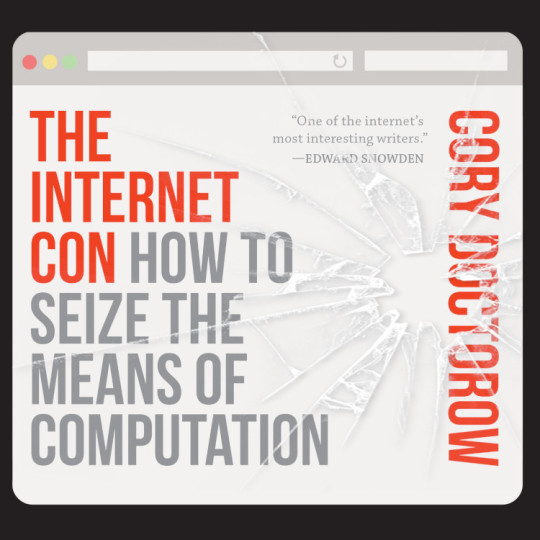
I’m kickstarting the audiobook for “The Internet Con: How To Seize the Means of Computation,” a Big Tech disassembly manual to disenshittify the web and bring back the old, good internet. It’s a DRM-free book, which means Audible won’t carry it, so this crowdfunder is essential. Back now to get the audio, Verso hardcover and ebook:
http://seizethemeansofcomputation.org

If you'd like an essay-formatted version of this thread to read or share, here's a link to it on pluralistic.net, my surveillance-free, ad-free, tracker-free blog:
https://pluralistic.net/2023/08/05/any-metric-becomes-a-target/#hca

[Image ID: An industrial meat-grinder. A sick man, propped up with pillows, is being carried up its conveyor towards its hopper. Ground meat comes out of the other end. It bears the logo of HCA healthcare. A pool of blood spreads out below it.]

Image: Seydelmann (modified) https://commons.wikimedia.org/wiki/File:GW300_1.jpg
CC BY 3.0 https://creativecommons.org/licenses/by-sa/3.0/deed.en
#pluralistic#hca healthcare#Gretchen Morgenson incentives matter#death panels#medicare for all#ibm watson#the algorithm#algorithmic harms#palliative care#hospice#hospice care#business#incentives matter#any metric becomes a target#goodhart's law
542 notes
·
View notes
Text

Today, President Joe Biden signed the continuing resolution that will give lawmakers another week to finalize appropriations bills. Lawmakers will continue to hash out the legislation that will fund the government.
Republicans have been stalling the appropriations bills for months. In addition to inserting their own extremist cultural demands in the measures, they have demanded budget cuts to address the fact that the government spends far more money than it brings in.
As soon as Mike Johnson (R-LA) became House speaker, he called for a “debt commission” to address the growing budget deficit. This struck fear into the hearts of those eager to protect Social Security and Medicare, because when Johnson chaired the far-right Republican Study Committee in 2020, it called for cutting those popular programs by raising the age of eligibility, lowering cost-of-living adjustments, and reducing benefits for retirees whose annual income is higher than $85,000. Lawmakers don’t want to take on such unpopular proposals, so setting up a commission might be a workaround.
Last month, the House Budget Committee advanced legislation that would create such a commission. The chair of the House Budget Committee, Jodey C. Arrington (R-TX), told reporters that Speaker Johnson was “100% committed to this commission” and wanted to attach it to the final appropriations legislation for fiscal year 2024, the laws currently being hammered out.
Congress has not yet agreed to this proposed commission, and a recent Data for Progress poll showed that 70% of voters reject the idea of it.
This week, a new report from the Institute on Taxation and Economic Policy (ITEP), a nonprofit think tank that focuses on tax policy, suggested that the cost of tax cuts should be factored into any discussions about the budget deficit.
In 2017 the Trump tax cuts slashed the top corporate tax rate from 35% to 21% and reined in taxation for foreign profits. The ITEP report looked at the first five years the law was in effect. It concluded that in that time, most profitable corporations paid “considerably less” than 21% because of loopholes and special breaks the law either left in place or introduced.
From 2018 through 2022, 342 companies in the study paid an average effective income tax rate of just 14.1%. Nearly a quarter of those companies—87 of them—paid effective tax rates of under 10%. Fifty-five of them (16% of the 342 companies), including T-Mobile, DISH Network, Netflix, General Motors, AT&T, Bank of America, Citigroup, FedEx, Molson Coors, and Nike, paid effective tax rates of less than 5%.
Twenty-three corporations, all of them profitable, paid no federal tax over the five year period. One hundred and nine corporations paid no federal tax in at least one of the five years.
The Guardian’s Adam Lowenstein noted yesterday that several corporations that paid the lowest taxes are steered by chief executive officers who are leading advocates of “stakeholder capitalism.” This concept revises the idea that corporations should focus on the best interests of their shareholders to argue that corporations must also take care of the workers, suppliers, consumers, and communities affected by the corporation.
The idea that corporate leaders should take responsibility for the community rather than paying taxes to the government so the community can take care of itself is eerily reminiscent of the argument of late-nineteenth-century industrialists.
When Republicans invented national taxation to meet the extraordinary needs of the Civil War, they immediately instituted a progressive federal income tax because, as Representative Justin Smith Morrill (R-VT) said, “The weight [of taxation] must be distributed equally, not upon each man an equal amount, but a tax proportionate to his ability to pay.”
But the wartime income tax expired in 1872, and the rise of industry made a few men spectacularly wealthy. Quickly, those men came to believe they, rather than the government, should direct the country’s development.
In June 1889, steel magnate Andrew Carnegie published what became known as the “Gospel of Wealth” in the popular magazine North American Review. Carnegie explained that “great inequality…[and]...the concentration of business, industrial and commercial, in the hands of a few” were “not only beneficial, but essential to…future progress.” And, Carnegie asked, “What is the proper mode of administering wealth after the laws upon which civilization is founded have thrown it into the hands of the few?”
Rather than paying higher wages or contributing to a social safety net—which would “encourage the slothful, the drunken, the unworthy,” Carnegie wrote—the man of fortune should “consider all surplus revenues which come to him simply as trust funds, which he is called upon to administer…in the manner which, in his judgment, is best calculated to produce the most beneficial results for the community—the man of wealth thus becoming the mere trustee and agent for his poorer brethren, bringing to their service his superior wisdom, experience, and ability to administer, doing for them better than they would or could do for themselves.”
“[T]his wealth, passing through the hands of the few, can be made a much more potent force for the elevation of our race than if distributed in small sums to the people themselves,” Carnegie wrote. “Even the poorest can be made to see this, and to agree that great sums gathered by some of their fellow-citizens and spent for public purposes, from which the masses reap the principal benefit, are more valuable to them than if scattered among themselves in trifling amounts through the course of many years.”
Here in the present, Republicans want to extend the Trump tax cuts after their scheduled end in 2025, a plan that would cost $4 trillion over a decade even without the deeper cuts to the corporate tax rate Trump has called for if he is reelected. Biden has called for preserving the 2017 tax cuts only for those who make less than $400,000 a year and permitting the rest to expire. He has also called for higher taxes on the wealthy and corporations, which would generate more than $2 trillion.
Losing the revenue part of the budget equation and focusing only on spending cuts seems to reflect a society like the one the late-nineteenth-century industrialists embraced, in which a few wealthy leaders get to decide how to direct the nation’s wealth.
[LETTERS FROM AN AMERICAN: MARCH 1, 2024]
Heather Cox Richardson
+
“The crucial disadvantage of aggression, competitiveness, and skepticism as national characteristics is that these qualities cannot be turned off at five o'clock.” —Margaret Halsey, novelist (13 Feb 1910-1997)
#poverty#trickle down economics#corrupt GOP#Letters From An American#heather cox richardson#ecoomy#wealth#“debt commission”#corporations#Margaret Halsey#government for the people
13 notes
·
View notes
Text
Charting the Course to SAP HANA Cloud
The push towards SAP HANA cloud shift stems from the need for agility and responsiveness in a dynamic business climate. The cloud promises reduced infrastructure expenses, robust data analytics, and the nimbleness to address changing needs quickly. However, for many companies, transitioning from on-premise SAP HANA to the cloud involves navigating concerns around data security, performance, and potentially relinquishing control of business-critical ERP systems.
SAP HANA Enterprise Cloud: A Tailored Offering
In light of these challenges, SAP presented the SAP HANA Enterprise Cloud (HEC), a private cloud service designed expressly for mission-critical workloads. HEC advertises no compromise on performance, integration, security, failover, or disaster recovery. It spotlights versatility, strong customer support, and end-to-end coverage - from strategic planning to application management. This offering intends to provide the cloud’s agility and innovation under SAP’s direct guidance and expertise.
Actual Delivery of HANA Enterprise Cloud
Despite SAP’s messaging, the HEC’s delivery involves a consortium of third-party providers, including HPE, IBM, CenturyLink, Dimension Data, and Virtustream. SAP collaborates with these partners, who bid on projects often awarded to the lowest bidder, to leverage specialized capabilities while upholding SAP’s standards.
Weighing the Pros and Cons
Partnering with competent vendors ensures clients receive secure, best-practice SAP hosting and support. HEC’s comprehensive solution integrates licensing, infrastructure, and support with touted scalability and integration.
However, several customer challenges emerge. Firstly, leveraging SAP’s brand for cloud hosting and SAP managed services risks diminishing anticipated cost savings. Secondly, the lack of direct engagement with third-party providers raises concerns about entrusting critical ERP operations to unseen partners. This dynamic obscures visibility and control over SAP HANA migration and management.
Furthermore, the absence of a direct relationship between SAP HANA users and cloud suppliers may complicate support, especially for urgent issues warranting rapid response. While SAP’s ecosystem aims to guarantee quality and security, intermediation can hinder the timely resolution of critical situations, affecting system uptime and operations.
SAP HANA Cloud: A Strategic Decision
As SAP systems become increasingly vital, migrating SAP HANA is not simply a technical or operational choice but a strategic one. SAP HANA transcends a database or software suite – it constitutes a competitive advantage that, when optimized, can spur tremendous innovation and success. This migration necessitates meticulous planning, execution, and governance to ensure the transition empowers rather than compromises SAP HANA’s strategic value.
In this context, selecting the ideal cloud model and service providers represents critical decisions. Companies must scrutinize partners beyond cost, evaluating track records, SAP skills, security protocols, and the aptitude to deliver personalized, responsive service.
The Future SAP HANA Cloud Trajectory
As we advance into 2024, the SAP DATA Cloud Analytics landscape continues evolving. Innovations in cloud technology, security, and service creation provide new prospects for migration planning. Firms must stay updated on cloud service advancements, SAP’s strategic direction, and cloud shift best practices to navigate this transition successfully.
To accomplish this, companies should:
Collaborate cross-functionally to align SAP HANA cloud plans with broader business goals and technology roadmaps.
Ensure chosen cloud environments and suppliers meet rigorous data security, privacy, and regulatory standards.
Assess infrastructure ability to support SAP HANA performance requirements and scale amid fluctuating demands.
Institute clear governance and support structures for effective issue resolution throughout and post-migration.
Transitioning SAP HANA to the cloud is complex but ultimately rewarding, unlocking efficiency, agility, and innovation when executed deliberately. By weighing the strategic, operational, and technical dynamics, businesses can drive this migration smoothly, fully capturing SAP HANA’s power to fuel future prosperity.
2 notes
·
View notes
Text
Sailor Moon Crystal (Season 1) Review
Let me tell you a story...

The year was 2011 (oh dear gods, that was 12 years ago HELP ME), and this Analyst was but a baby, burgeoning weeb. A mere 17 years old, set to turn 18 in November of that year. I'd just finished high school (grade 10) and was off to complete what my state refers to as college - In reality, years 11-12 of high school, just at a different institution, because I don't know, take it up with the state government.
I was still fairly new to being a weeb - I'd only gotten into anime midway into 2009, and for all that time, I'd had a friend who acted like my "supplier" - Bringing me a 2GB USB stick to school each day, loaded with .RMVB video files of whatever anime he wanted me to watch next. Honestly the setup was a little strange, in retrospect, and he was ODDLY secretive and gatekeepy about it, treating it like this special thing between us and... The more I think about it, the odder it gets but ANYWAY...
That "supplier" friend had since moved away (I shit you not, he was trying to get into a Japanese Exchange Student program, again, I shit you not). So had my best friend. All other friends I had had popped off to another college. I was alone, at a new school, with no friends. It's 2011 - i'm still a year away from meeting the love of my life, what little social life I had is crippled, my closest friend is gone, and the supplier of Japanese-Cartoons-That-Brought-Me-A-LOT-of-Joy-And-Pissed-Off-My-Mum-For-Some-Reason is currently trying to actually transform his life into one of said cartoons, complete with Japanese High School - Again, I am not kidding.
This left your not-so-dashing Analyst with no one to share a fanboy moment with, no one to give him the next show that he could get into, no one to argue about who the Best Girl™ was... Just a single weeb, alone.
This was 2011 - At this point, anime was slowly seeping into the mainstream scene, but we were a long way off the "grade schoolers declaring "My Hero Academia is my comfort show" stage, and where I am is slower than most places at catching up to mainstream pop culture anyway.
I did have a couple of things going for me. I had the websites where my "supplier" had used to download all that fansubbed anime, and I had what I would currently do unholy, unspeakable things to get back... Time.
So what was this Junior Weeb Analyst to do? I cast my mind back to some of the things that led me to get into anime in the first place. I thought back to many, many cartoons on before-school shows like "Cheez TV", that only later did I realize were indeed anime.
And so, with a mindset forming that "to appreciate what we have, we must understand where it came from" (something I still hold as true to this day), I set myself off on what I - melodramatically, but consistently - refereed to as my "tour". I vowed to return to the shows that had led me here, and see them as they were meant to be seen.
(That meant in subtitled Japanese of course - The Sub vs Dub debate was alive and well back in those days, and this idiot analyst was firmly on the "Sub" side. I've grown a lot since then, and also I think that debated ended by mid 2013 as dub quality had MUCH improved. Now most anime I watch is in dub.)
I watched a LOT of shows on that tour. Dragon Ball Z, Cardcaptor Sakura, even a decent hunk of the original Pokemon (in JAPANESE)... And among those shows, and perhaps the one that took me the longest to get through but also left itself with a special place in my heart, I watched Sailor Moon.

I've GOT to get better at cutting to the point during these introductions...
It's funny how, over a decade later, things have a way of repeating in the most unexpected of ways. Of course, I'm not alone anymore - I have a wonderful partner who I met in 2012, and we've been together for all this time. I meet almost weekly for Discord calls with my best friends. I have a full time job and a steady income - Things couldn't be further from the days when I took that "tour" and yet...
As my previous review might have indicated, I've been tackling some personal stuff lately. To say the landscape has changed from those days is like saying that the ocean is damp. Bogged down by negative fandom interactions and a deluge of toxic and ever-prevelant socaial media-fuelled opinions, it's only recently that I've gone: "fuck it, I'm taking a break" - Cutting out a that online loudness left me in a quiet space where for once I could just... Enjoy things again.
So, replacing pirated .RMVB files with Blu-Ray disks, and the chance to really "get into something" again, where did my thoughts to turn? Well, I found myself thinking of that old "tour". And whilst that had been about a return to the path that led me where I was, I decided I wanted to watch something that could represent the present-and-future. And wouldn't you know it, thanks to some advertising for an upcoming movie, I remembered that, sitting on my shelf, buried amongst the "I swear I'll get to this someday" series, was the perfect series for that exact purpose.
A remake of Sailor Moon:
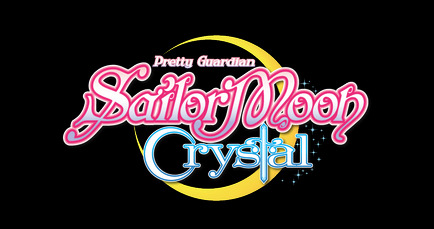
Sailor Moon Crystal
Phew! Okay! We've finally arrived at the actual POINT.
My formative years as a weeb had already left me with a soft spot for Magical Girl anime - You've just read all about my journey to watch Sailor Moon - So when a truer-to-the-manga anime adaptation was released in 2014, of course I knew about it. I recall watching maybe 3-4 episodes of it, in Japanese, before dropping it for reasons I don't recall, but I'm sure made sense at the time. I've always been meaning to get around to it, and seeing that Pretty Guardian Sailor Moon Cosmos The Movie was coming out this year was really a kick in the rear to go and watch the damn show.
As of 04/04/2023, I have now fully completed the first season, and thus, decided to write up my review - I'll state again for anyone that happens to be reading this for some reason (and if you're still with me, congratulations, you made it through my rambling, Granpa Simpson-esqu introduction - Now run because dear god, it doesn't end there, save yourself.) - I write these reviews and thoughts down as a mental health exercise, to put my thoughts somewhere that I can revisit them. I act as though I'm speaking to an audience, but the only real intended reader here is me. Still - if you ARE reading this, I state that these are only my opinions. They're not objective in any way. If you disagree, that's fine, feel free to tell me even, but I'm not out here to change anyone's mind.
Having finally got all that out of the way, lets yell "MOON PRISM POWER, MAKE UP!", change into our Sailor Uniforms and dive into it. Spoilers ahead!

Many smarter, more well known, better read and well respected reviewers and analysts of media have said that a piece of media should be judged on it's own merits, and not compared to previous adaptations, original source material, or other related pieces of media.
That's good, solid advice, which I agree with and am now about to throw out the window, because this review is going to compare Crystal to the original Sailor Moon anime A LOT.
The thing is, I don't think I can be fully fair to Crystal WITHOUT the comparison, and the reason I think that is fairly straightforward:
Sailor Moon Crystal is not intended as someone's first entry into Sailor Moon.
(Again. Purely my opinion. Disagree with me if you like.)
Let me explain:
I am not unfamiliar with Sailor Moon, as you might have guessed. Whilst I have only watched the original anime series (and it's associated movies), I am aware of the original Manga, I'm aware that Crystal is trueER to that text than the first anime, I'm even aware in a cursory capacity of the live action TV and stage shows.
And I think this knowledge is somewhat assumed for viewers heading into Crystal because, without it - It can feel very rushed. See, fans of the Manga have read the manga, they know what happens. So if they're watching it because they want to see a manga adaptation, well, they're heading into it fully armed with that knowledge.
Similarly, a fan of the original anime like myself is most likely watching this because "OOOOH, NEW SAILOR MOON" and it's reputation as being truer to the manga. We're heading into it for the sake of seeing the characters, setting and plots we know and love.
Someone who has no prior knowledge of Sailor Moon would not head into this anime with any of that, and thus, would be caught off guard by it's rapid, almost too fast, pacing, multiple character introductions, lack of characterization and in some cases, no real explanation for a number of things. I would imagine that Crystal would not be an especially incredible, or in some cases, even good experience for that person.
Crystal is for the fans. The fans who know what's coming. In the first three episodes, Crystal rapid-fire introduces characters, not just limited to Usagi/Sailor Moon and Mamoru/Tuxedo Mask. We get Ami/Sailor Mercury in the second episode, Rei/Sailor Mars in the third, a major confrontation with long-standing original anime starter villain Jadite in the fourth, before we're hit with Makoto/Sailor Jupiter in the fifth.
Fans of the original anime will remember that that sequence of events, taking place over five episodes in Crystal, took some 20+ episodes in the original. And between those FOUR major events, we had countless episodes of one-shot characters, monsters, Usagi being a crybaby and refusing to do anything, Rei being a bit of a bitch, Mamoru throwing roses and then leaving because "MY JOB HERE IS DONE!" and Queen Beryl waving her hands ominously over a crystal ball and babbling about "energy" so much that the word starts to sound weird.
For fans of the original anime, we've see that, and everything that involves, both good and bad, is already known to us. We don't want to see that again - Just give us the other Senshi already! We want to see Mercury, and Mars and Jupiter and Venus. We want to see the confrontation with Queen Beryl and Metalia and the showdown in the arctic and Usagi and Mamoru hooking up and all of that stuff, and that is what Crystal delivers, in short order, one event after another. There’s very little “filler” even in the more modern sense of the word (I talked a bit about “filler” in my last review). Basically every scene serves the purpose of advancing the plot to the next “touch point”, which does unfortunately cut out a lot of the less dramatic, but still enjoyable stuff.
Crystal is best taken with prior Sailor Moon knowledge, which means you mentally fill in a lot of gaps that the anime itself would otherwise leave you with. Having virtually no filler means things move almost too fast, and sadly, in that rush, some really great character moments are lost (perhaps most disappointingly, the same-sex relationship between villains Zoisite and Kunzite is completely gone, although as compensation, Crystal does show more of Usagi's bisexual side and hints toward her fleeting crush on Rei - We'll talk more about this later).
To be fair to Crystal, to prevent it being weighed down too heavily by these issues, I will compare it to the original anime, and see how it shakes out when taken with the knowledge that a viewing of the original 200 episodes brings. That’s how I went into the series, and that has an inextricable influence on how I enjoyed it.

Let’s get this out of the way��
Crystal is not as pretty as the original anime.
It’s not even remotely close.
I hate to start by criticizing Crystal right off the bat, but it has to be said.
The original Sailor Moon anime was produced in 1992. It was made at a time before the widespread use of CGI and digital colouring. It’s an adaptation of a Shojo manga, and was primarily drawn, coloured and animated by hand. It’s pretty, soft, girly and pastel and HOLY FUCK IS IT BEAUTIFUL.
Look at this.

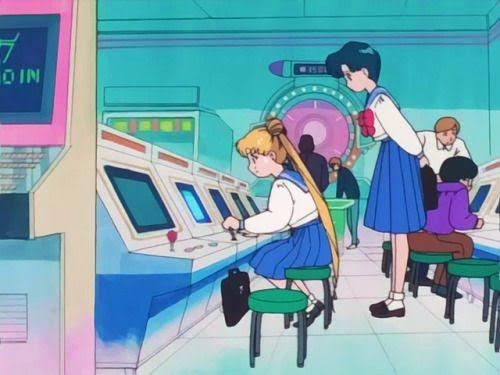
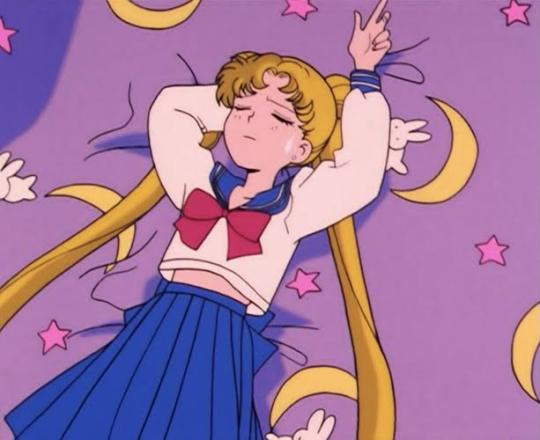

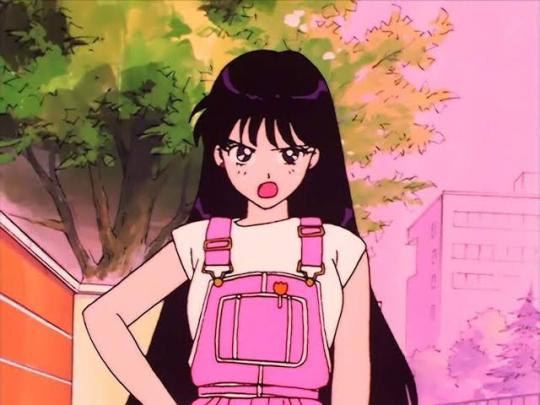


Like, god-the-fuck damn it. Look at these.
Look at that last one (side note, what the hell are you doing Mamoru?). If you were to remove Usagi and Tuxedo Mask from the image, you'd be left with something I've seen tagged on tumblr as "Pastel Liminal". There are plenty more. In fact, I could just whack in one of my DVD's of the original anime, set my computer to screenshot at random intervals, and you'd see nearly infinite examples.
The original Sailor Moon anime was lightning in a bottle. It was produced at a time where things were produced by more analog means for the most part. It was adapting a source material that already had a gentle, soft and pastel theme to it. It's drenched in the fashion and style of the early 90's/Late 80's. All of these factors combine to create a piece of media where the best examples look like genuine works of art, and even the worst, most off model in between frames still carry a unique, warm and nostalgic charm.
I don't think it's a coincidence that the visuals of Vaporwave - a musical genre built on evoking feelings of nostalgia and popular culture - share much of the same color pallet as any random episode of '92 Sailor Moon. I think there's something unique about pink pastels, soft coloring and imagery from the 80's/90's. And people have noticed this. The feelings of liminality and atmosphere are present all throughout Sailor Moon - To an even greater degree than things like The Simpsons.
There are enough screencaps of Sailor Moon on people's
A E S T H E T I C
blogs on pinterest and tumblr and the-horror-site-that-I-escaped-and-will-not-name that if we combined them all together, I honestly believe we could recreate whole episodes of the anime.
NOW LET'S LOOK AT SOME SCREENSHOTS FROM CRYSTAL.




Now. Not a single one of these is BAD. I actually avoided any screencaps that were off model or "QUALITY.MEME" style or anything. They are crisp, clean, vibrant... And not especially distinct from any other anime of today.
(And yes I'm aware that much of the same argument could be said for multiple older anime vs new anime, that's not the point I am making.)
Look at the backgrounds. Compare them to the original anime. Neither is bad, but you can not deny that the original is dripping in that "Aesthetic", and it always will be, whilst Crystal will always just be "yeah, decent 2010's anime". In 20 years from now, there won't be any more blogs devoted to Crystal's aesthetic than there are for any other anime, and to a degree that kinda sucks.
Does it detract from the experience? Not really - But the comparison has to be made. Plenty of people watch Sailor Moon these days for it's retro-nostalgic vibes and if that's what you're looking for, those are not present in Crystal.
And...Yeah the Cell-Shaded CGI. I don't actually really mind it - I quite like cell-shaded CGI - but it sure is a bummer to see the Transformation sequence use that. Of all the time they could have used it, they chose to use it on the iconic transformation scenes.
Hand drawn animation isn't the only thing that's missing from some of the most important scenes. Let's talk about the soundtrack.

I'm not musically talented, so I'm not inclined to talk about music too much. It's not that I don't enjoy it, but I don't feel qualified to say too many things about it.
(I'm not artistically talented either, but for over a decade, I have been in a serious relationship with a very talented artist who lives in the same house as me, so I picked up a few things and feel that I can at least offer an opinion on the art)
To save me repeating myself, I'll just say that the soundtrack to the original '92 anime is almost as iconic as it's art. The upbeat guitars and violins and trumpets and pianos and god-knows-what else that played throughout that series are a big part of it's identity.
Crystal does have it's own musical identity. It's a bit... blander in parts...
(there's this one recurring piece that tends to play during epic or emotional moments that, thanks to my oh-so-wonderful partner, I can't hear as anything other than that awful "Where are you Christmas" meme song).
But other times it does suitably convey majesty and grandeur to the scene's its playing over. The transformations may lack the rock-styled guitars of the original, but they have this new piece that sounds very magical and epic for Sailor Moon, and for the other senshi, they actually do bring back in the harder beats. Sailor Mars' first transformation goes particularly hard.

There's another piece of music I just have to talk about

The opening theme, "Moon Pride" is a fantastic piece of music, with some great visuals included. I particularly like how it's not only partially sung as if "in character" by the bands members as the Sailor Senshi, (I originally thought it was the senshi's Japanese VAs, but apparently not) but certain lyrics carry a specific "flavor" relating to that senshi - "Jupiter" and "Venus" singing lines about how "Love hits like a flash of lightning".
The tune and lyrics are extremely upbeat as well, singing of the power of girls ("girl power" being something that's extremely important to Sailor Moon) and how they have the power to accomplish their goals. It even incorporates the "Make Up!" phrase used by the senshi in their transformation, and ends on "La La Pretty Guardian SAILOR MOON" - A line that sounds clumsy when I write it down, but really does work in sung form (plus, I will always give props to a show incorporating it's title into the lyrics).
It's such a great song. It's a great opening visually too - Lots of wonderfully arch typically "anime opening" stereotypes in all the right ways, like Queen Beryl gesturing menacingly while the Four Heavenly Kings whiz in to pose with her and the specter of Queen Metalia rising up behind them...
It's honestly fantastic and a great choice for the series.
It's too bad I hate it.
It's not the fault of the song. It's just impossible for it to stack up against Moonlight Densetsu.
This is why we shouldn't compare things so directly, because shit like this happens.
Moonlight Densetsu (or, Moonlight Legend translated into English) is an iconic piece of anime music in it's own right, and it's connection to Sailor Moon is inseparable. Go ahead, go look it up. You want to, now that I've mentioned it. Better yet, I'll save you the trouble. Go on and listen to those iconic chimes at the opening before the guitar and the piano kick in....
youtube
Even the original english dub, with as many nonsense changes as it made, and at a time where it was common to record a whole new song for dubbed a anime's OP, kept the actual tune and music - It just replaced the lyrics (with very catchy, if somewhat inaccurate ones I might add... "Never running from a real fight"...)
And of course, the Japanese lyrics - evocative of a love song between Usagi and Mamoru - are catchy, charming and beautiful, evoking that same feeling as the anime's visuals provide. That tone, that aesthetic, and these days, that nostalgia. But it doesn't end at just the Japanese version...
The funny thing is, that even in today's day and age, with access to dubs of equal, if not superior quality to the original language, and most opening themes left untouched... if you start this tune up at any convention, you'll probably every weeb in hearing radius chime in with:
"~Fighting evil by moonlight~!"
Those english lyrics are just as iconic as their Japanese originators. The same opening theme, done two different ways, completely iconic in both the East and West parts of the world.
In preparation for writing this bit of the post, I asked myself to find the most iconic anime openings. The kind that everyone can sing along to at a convention. I found plenty - so I asked myself, what's one that everyone can sing along to in both English and Japanese.
See, everyone can jump in for something like the opening for "Attack on Titan" or frantically try to dance along to Motteke Sailor Fuku (Lucky Star's intensely energetic opening theme) for Japanese songs, and almost anyone past a certain age on the street can probably sing along to the absolutely legendary english opening for the original Pokemon anime...
But there's probably only one opening I know where everyone is able to get on the same tune, singing about the same show, in the same way in both English and Japanese.
And that's Moonlight Densetsu.
A remake is a remake, and it shouldn't need to rely on nostalgia, or try to win points by including whats already been done.
But there's an exception to every rule and god-damn should Crystal have used that piece of music.
It didn't even have to be the opening. Play it in the background as Usagi vanquishes Queen Metalia.
It's SO iconic to Sailor Moon that nothing, not even Moon Pride could replace it.
The fact that Crystal doesn't use Moonlight Densetsu genuinely detracts from the experience for me. It doesn't ruin it, but it's definitely a missed opportunity. I've heard they've so far not used it, and my fingers are crossed they'll work it into the finale movies somehow, because I would just love to hear it one more time in a modern context.
Alright - I feel I've rambled enough on the negatives. By now, I've made it clear... Crystal is not a replacement for the original '92 anime.
Lets talk about what it does get right.

If I've sounded negative up till now, it's only because I genuinely have a lot of love for Sailor Moon that I almost hold it to a higher standard than a lot of other anime series. If this were a remake of almost any other 90's anime, I wouldn't have that much to say - either for or against. I've fallen into the trap before where people think I hate something because I've been talking for 100 years about its flaws and missteps and I have to explain that no wait, this is actually one of my favorite things...
I've always been the kind of guy that takes a very deep interest in what I love. Goes with the autism I suppose. When you look into something that deeply, you see its flaws as clearly as you see its merits, and quite often, the flaws are easier to talk about.
I could talk about the flaws in the original Sailor Moon anime too. I could talk about how it's got 200 episodes, and yet, I think a count exists where only 50ish of those episodes are plot relevant, and a further 10-or-so of those could be whittled down to "X got a new power up/attack/transformation"
I could talk about how the anime relied on stock footage to absurd levels, fights often coming down to watching the same animations a couple of times before they play the usual stock "Usagi defeats/purifies/vaporizes/love-bombs the bad guy" clip.
I could talk about how, when you have to stretch some fairly straightforward characters out over that many episodes, you wind up pulling out a lot more of those characters negative traits for the sake of inventing some kind of drama to drive some kind of plot along, in the worst cases making some characters borderline unlikable.
Or, I could talk about how Crystal AVOIDS those problems like the fucking plague.
Well. Not all of them, obviously. But it is here, in the character department we see our first marked improvement.
While the rapid pace of Crystal does leave some characters in the dust - a lot of them on the villain side of things - one thing it does help with is there's no need to invent "drama of the week" between the girls. There's no need to have Usagi and Rei bitching at each other because the boy-of-the-episode isn't paying them attention or to cram in a "someone's got a crush on X, and the other Senshi are going to spy and stick their nose in her business because OOOOOH ROMANCE". There's no need for a weird, shitty subplot where Rei dates Mamoru.
While the characters don't feel as fleshed out as in the original, that actually works when you see their relationships. They first form a friend group based on their shared destiny, and then, once they recover their past-life memories, solidify their bonds based on that.
And you can call this cheep and lazy, and maybe it is, but I can't help but think that it just WORKS for them. When the original had so much bickering and insults without showing as many moments of genuine care between the Senshi, it's just damn refreshing to see them unambiguously care so much for one-another. I know they did in the original too, but here, it's so much faster and tighter that it really comes off better.
To varying degrees, all of the Senshi are affected by this "tighter" (or perhaps "faster") pacing, but none more so than the titular character herself, Sailor Moon. AKA, the klutzy crybaby, Usagi Tsukino.
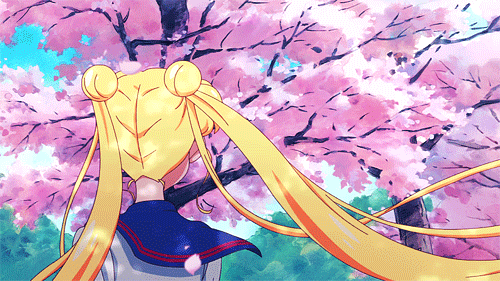
Usagi is a character that is very much the face of the series in every conceivable way. Aside from being the titular Sailor Moon, her visual appearance is iconic, to the point that even non-anime fans could probably identify her as "Sailor Moon" if you show them a picture, and even today, as the older generations of anime fans and weebs are replaced by a whole new breed of both dedicated and casual fans, most of them will still know who Usagi is. Her iconic "odango" (Bun/Dumpling) hairstyle is still homaged and parodied today, even in western cartoons:

(I'll spare you my endless rants on Star vs The Forces of Evil...)
Usagi's characterization is similarly iconic, helped by the fact that she herself narrates the opening to many of the numerous episodes of the original series with an honest description of herself. The translation varies from fansubs to the modern official dub, but the gist of it is always:
"I’m Usagi Tsukino and I’m a 14 year old middle school student. I’m a bit of a klutz… and kind of a crybaby. One day, a cat named Luna gave me a special brooch that transformed me into a guardian in a sailor uniform and told me I had to fight bad guys! Boy, does that ever make me nervous. But, I’m sure it will all work out fine!"
Right off the bat, this establishes Usagi's personality. She's emotional, ditzy, but optimistic. Over the course of all the series it's established firmly and consistently that she's a dreamer and an utterly hopeless romantic. She gets bad grades, overindulges in food and sweets, doesn't study, but also has an overflowing amount of love for just about everyone, especially her friends, and her kind-heartedness is always centered.
Thing is, with the original '92 anime being 200 episodes long, with a lot of those being filler, where they needed to have a plot driven by characters without being allowed to do anything to drastically change those characters, they needed to fall back on Usagi's basic characterization for day-to-day episodes. There are a LOT of scenes of her just being kind of....
Well, I don't want to say "useless" but...
Usagi's slacker tendencies were highlighted, along with her selfishness and hedonism. She'll drag her friends along to things they don't want to do, borrow their stuff, and is generally kind of treated with a sense of being a load by them a lot of the time. All of these are consistent traits across all adaptations, but the '92 anime practically spotlights them. She often needs to be coerced or pressured into actually transforming into Sailor Moon and doing something, and even when she did, she more often-than-not relied on a well timed rose from Tuxedo Mask and an attack from another Senshi before she broke out the finishing move. In my younger days, when I attended more conventions and hung around with other anime fans, it was pretty common for them to express a kind of distaste for her as a heroine.
It's not that the original anime didn't have it's moments of highlighting that, y'know, Usagi is a true all-loving heroine with determination, dedication and a love for her friends that would net her the most dramatic power up scenes if the show were a Shounen anime, but they tended to be reserved for the plot relevant episodes, and as mentioned, the original anime is 3/4ths filler, so we get a lot of selfish, crybaby Usagi.
Crystal, on the other hand, moves at a speed so intense that only astronauts trained in special machines by NASA can withstand the sheer g-force it generates. Seriously, it feels like the plot took a leaf out of Usagi's book and overslept, forcing it to charge forward like:

This does something interesting to Usagi as a character. While we're shown enough of her at school to know that, yes, she gets bad grades, scores awfully on tests, and is an absent minded klutz who'd rather slack off and visit the arcade than do anything related to actual school, it also shows Usagi:
Genuinely reaching out to Ami and befriending her, wanting to bring her out of her shell and let the overworked girl have some fun.
Defending Rei from some women who are blaming her for circumstances beyond her control. (Crystal also famously restores the scene where they meet because Usagi follows her off the bus, hearts in her eyes and all. Usagi's implied bisexuality is restored and it's obvious she's got some kind of crush on Rei.)
Complimenting Makoto on basically everything: her cooking, earrings and her perfume, giving the girl a much needed ego boost.
Borderline worshiping Minako (as Sailor V) and then genuinely looking up to her once she meets her as Sailor Venus.
(Also. this is just fanboy bullshit, but Crystal makes Sailor Venus' transformation use ribbons, much like Usagi's, and given that Venus outright states she's the original leader of the Senshi, and her "in the name of Venus" speach sounds very similar to Usagi's "in the name of the moon" spiel, I like to believe that Usagi is subconsciously basing her Sailor Moon act on the memories she has of her former guardian.)
The result is that Usagi's friendship with the other senshi feels very genuine. They do a little teasing of her, of course, but are also extremely loving toward her, a feeling that only grows as they regain their past memories and remember her both as their sacred Princess and their middle-school friend. There's a very sweet scene where they all sit around her and help her fix her hair up, stuff that really shows that these girls are true companions and a proper team, not a misfit group of conflicting personalities.
There's also a scene toward the very end where, after Sailor Moon is compromised in the final battle, all of the Senshi draw the strength to keep fighting to the bitter end by remembering Usagi, which is punctuated by actual clips of things she's said to them. It's a bit clumsy (Jupiter's memory is the scene of Usagi talking about her earrings and perfume...) but the fact that it is all footage we've seen before makes it believable.
She's also far more proactive and direct. While she does wail and cry a couple of times at the monsters, other times she actually just swallows her fear and charges forward to save her friends. There's an incredible moment where, confronted by a group of zombified people, without so much as a single "SAVE ME, TUXEDO MASK!", Usagi transforms and purifies all of the zombies with her finisher, before actively moving to seek out the source of the the corruption. It's an awesome moment.
Her moments of "uselessness" in battle are also given a facelift. Given that Mamoru/Tuxedo Mask himself is far more active and involved in battles. Instead of crying out of fear and cowidance, Usagi is usually taken out of the fight by her hopeless romantic nature being taken advantage of. She's either hit with some revelation or otherwise emotionally compromised. Usually by putting Tuxedo Mask/Mamoru in danger.
Indeed, Crystal really emphasis Usagi's emotions in a way that makes her feel very fragile and vulnerable at times. She's instantly taken with Tuxedo Mask, and when she later uncovers his identity (or rather, he reveals it to her), she becomes caught up in their love, to the point where, once he's taken from her by the Dark Kingdom, she struggles to fight back against him. There's many scenes where it's simply those two, and although they don't fight, they don't need to, because the act of seeing her true love (and the anime establishes very quickly that yes, Mamoru is her true, destined lover) on a side that isn't hers is enough to paralyze her. On the other side of that coin, when he's not in opposition to her, Usagi really doesn't let anything slow her down, and genuinely is ready to get into a fight for the sake of bringing Mamoru back.
The ending, which finally puts them back on the same side, allows him to be her emotional support as she battles it out with Queen Metalia in the final confrontation, again plays up Usagi's emotions, this time drawing strength from her love for Mamoru and her friends, allowing her to finally banish the evil. It's not dissimilar to how the original series ended it's first season - Although the fact that we do see scenes of the Earth being reduced to chaos and nothingness by Queen Metalia does make a very interesting backdrop.
i feel like I'm rambling here, so I want to sum it up - Crystal manages to make Usagi a far more proactive and engaging force in the narrative, without taking away the "crybaby and a klutz" part of her. The focus on her vulnerability shows why she needs her friends and her love, but on the other hand, we're also shown that, when she does have that, there's not a lot she can't do, and she more than possesses the strength to take action.
As for the others...
Like I said, everyone fares a bit differently. I've ranted a bit too long about Usagi because, in my opinion, she's the one who mostly gained good things out of the pacing, losing a lot of what she was commonly derided for in the original setting, but the other characters are slightly more of a mixed bag.

My bishie boy Mamoru/Tuxedo Mask get a lot more to do very quickly, compared to the original series. His search for the Legendary Silver Crystal™ is mentioned a lot, and he kicks off one episodes problems by declaring it publicly. His identity is also not really kept a secret, and we're shown Mamoru wearing the tux on many occasions without the cape, hat or mask.
His relationship with Usagi is... Well, it's there. Because of the compressed nature of the series, he runs into Usagi a fair bit less than he did in the original, and thus a lot of their banter is gone. While Usagi falls for him very quickly, he's at least shown to care about her, and once their identities are revealed and they start to recover their past lives memories, they do feel very in love.' Because of the compressed nature of the series, he runs into Usagi a fair bit less than he did in the original, and thus a lot of their banter is gone. While Usagi falls for him very quickly, he's at least shown to care about her, and once their identities are revealed and they start to recover their past lives memories, they do feel very in love. The few times we get to see them together outside of them being in mortal peril are very sweet.
(I know their relationship has always been... controversial, so I won't dwell too much on it. These type of things are fairly common for anime in general, so it's something you need to just accept if you plan on watching a lot of it)
He does seem to take on the "useless" traits that Usagi lost though. My boy here borders on being a full on damsel in distress sometimes. His rose throwing was corny in the original anime, but it was usually effective. Here, there's not a rose in sight, leaving him either as an observer, or as normal, albiet sharply dressed, man who's quite out of his depth against monsters... BUT as an unabashed and unashamed lover of Damsels in Distress, I hardly mind that.
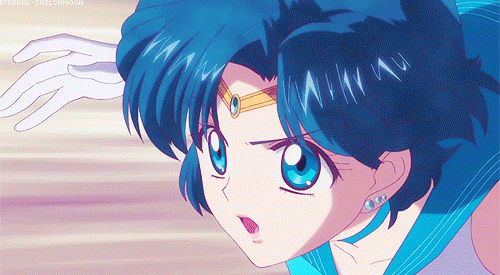
Sailor Mercury/Ami is one of the ones who got more of the short end of the stick from the pacing and rapid nature of the show. She's established, as per usual, as the super smart genius with some genuinely sweet moments of Usagi helping her out of her shell. However, because the show introduces the other senshi so rapidly, she rarely gets a chance to stand out with her genius. She does smart-stuff, sure, we always see her on the computer and the like, but rarely do we actually see her express that genius in any way other than pinpointing an enemy's weakness by scanning it with her goggles or something. Granted she did a lot of that in the '92 anime too, but at least then there were episodes that showed her studying or taking tests and a couple of times where she needed to use her intelligence against the monster of the week.
It's not like the show "does her dirty" or anything, Mercury has always failed to stand out compared to the others, owing to her more down-to-earth personality and seriousness, in both the '92 series and Crystal. Part of that in both instances is because after we meet her we're very quickly (or in Crystal's case, immediately) introduced to...

Sailor Mars/Rei has always been a tad on the polarizing side. She either tends to be a fan's favorite or they hate her outright. Rei is fiery and outspoken, and in my opinion, after Usagi, she's the one who benefits the most from Crystal's fast pacing.
The '92 anime had Rei as far more confrontational and borderline bitchy. She clashed with Usagi so much, outright challenging her leadership at least once, that it was hard to believe they were friends. Although she did always come through for Usagi at the end, the status quo meant she'd be right back to digging at her the next episode.
Crystal has Rei instead under immense pressure right from the start, justifying her stand-offish behavior, and has Usagi defend her from a group of mothers who wanted to blame a number of disappearances on Rei's psychic power, after which Rei becomes very open to her. She's still serious, and she still gets one-or-two digs in at Usagi being a lazy glutton, but she comes across as far friendlier. Her psychic powers mean she takes to being a Sailor Senshi pretty much straight away, and she's usually the one to go on the offensive in battles. While that "mean-streak" gave her a notable characterization in the original series, here we get to see a kinder, and gentler side to her. She gets plenty of dialogue that indicates she's taking the job seriously, but also that she wants whats best for Usagi. It's a sharp contrast to the girl that tried to steal her boyfriend in the original series.
(Speaking of, considering the series restores her semi-crush on Rei, you have to wonder if Usagi's type is just "dark haired, vaguely mysterious and teases me on occasion")

Jupiter is pretty "middle of the road" here. Crystal takes away her recurring joke of comparing every boy to her "sempai", but it doesn't really add anything more to her character. We get to see more of how, despite being big and strong, she's quite feminine, but beyond that, she doesn't really do anything to make herself stand out. Her character here is neither an improvement, nor a deterioration.
Honestly, Jupiter was one of my favourites in the original, so I really thought I'd have more to say, but I just don't. She's fine.
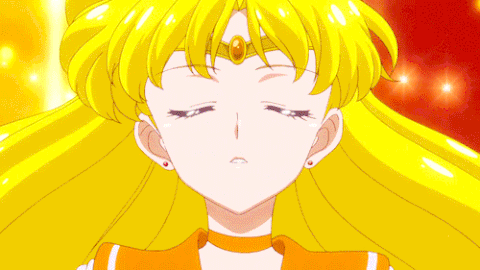
Sailor Venus/Minako has the unfortunate title of being the final Senshi introduced formally (No. We're not counting her appearances as Sailor V. This post is too long already for me to talk about that). As a result she gets... very little time to shine as a character. Minako especially loses all of her quirks and goofy traits from the original, though we do get to see something else as a result. She's very rarely seen doing anything other than her duties as a Sailor Guardian. Compared to the other senshi, this means that it comes off less as Minako transforming into Sailor Venus to fight evil, and more as Sailor Venus disguising herself as Minako. She explicitly has most of her memories restored right from when we meet her, and thus fully embraces the role of "Leader of the Sailor Guardians", knowing more about their enemy than the others, and helping them along with revelations.
Also - there's this beyond-stupid bit where she claims she's the Moon Princess for an episode or so... It's vaguely implied to be a bluff (for some reason), but even so, it's fantastically stupid and accomplishes very little.
(Not going to talk about the cats or other more minor characters because... well quite frankly this post has gone on for way too long already)
Finally that brings us to the villains.

Yeah look... Fans of the original portrayal of the Four Heavenly Kings are out of luck here.
The '92 anime had a habit of using one king at a time to unleash some monsters, but baring Jadite, all of them developed some pretty distinctive personalities in that time. From Nephrite's arc of falling in love with a human, to Zoisite and Kunsite's explicitly gay and genuinely affectionate relationship, 3 out of 4 of them got pretty memorable scenes and personalities.
Not so for Crystal...
*sigh*
Yeah, all of them are pretty generically "evil" in this version. They really, really do not stand apart from each other.
It's all the more disappointing as this series goes with the "each king is the destined lover of one of the Sailor Guardians" idea that has been around for a while. I'm not sure if this was ever in the original manga, but it's been something that's been known to fans for basically forever.
Sadly though, the anime does very little with that. Honestly, it's only worth mentioning because in this version, the senshi are able to turn them back to the side of good... after which time Queen Beryl/Metalia destroys them and they turn into the little gems they're named after as if they're straight out of fucking Steven Universe.
I know the limited episode count and nature of being truer to the Manga wouldn't allow anything like the original anime, but would it have killed them to show Kunsite and Zoisite with their arms around each other? Or better yet, if they wanted to do the "destined to be with the Sailor Senshi" thing, give us some one on one scenes with each pair?
Queen Beryl does get a bit more character though. (Hence why I used her picture up there). We get to see flashes of her past, as a princess of earth, hopelessly in love with Endymion, and is actually the one who tried to strike down both him and Princess Serenity in the past. She also has plans to pull a Starscream on Queen Metalia, and goes into battle herself a couple of times. It's a consolation prize for the disappointing turnout of the four kings.

OVERALL
This review has really gotten out of hand. I feel like I spent too long talking about the original series and the blundered onto the Crystal stuff really haphazardly.
To wrap it up, I'll repeat that I don't believe Sailor Moon Crystal should be anyone's first introduction to Sailor Moon. It needs to be approached with prior knowledge and familiarity, lest a lot of what makes the series special feel instead rushed and half-baked. Because, that really is what makes a lot of it good, at least to me. Seeing things happen at a faster pace, with a lot of the unpleasant aspects of characters removed is a breath of fresh air when your standard experience amounted to over 100 episodes of filler.
It's a good show. It's a fun show. It's a show that I, as a fan of Sailor Moon, enjoyed...
...And despite the length of this review, it's one I can't really give an opinion on yet because you see... Unlike the original, there is no filler arc about a tree and the aliens who want it to grow. Season 1 of Crystal ends with Rei receiving a premonition of a black, upside down crescent moon, and a mysterious pink haired child falling out of the sky..
As of writing, I am over halfway through "season 2", which has both countered and enhanced some of my above points, so I want to stop there before I say too much more. I'm going to try and review each "season" on its own.
I suspect from here on in, given that I've said my piece about how it compares to the original, the next reviews shall be a bit shorter, or at the very least, will have less of me rambling about how not using Moonlight Densetsu is a crime against nature.
Either way, if you have stuck with me, or read this entire post for whatever reason, regardless of whether you agree or disagree with me, I'd like to thank you for taking the time. I feel good having gotten this all off my chest, and I look forward to writing up another one.
But now, I must go!
The Analyst has vanished in a swish of his cape, leaving behind nothing but a single rose.
#sailor moon#sailor moon crystal#sailor suit#anime#manga#sailor venus#sailor mars#sailor mercury#sailor jupiter#usagi tsukino#Usagi#moonlight densetsu#REVIEW#OPINION#magical girl anime
6 notes
·
View notes
Text
Ensuring Compliance with the Best Healthcare Suppliers
Compliance is a critical aspect of the healthcare industry, ensuring that medical facilities meet regulatory standards while delivering high-quality patient care. Partnering with the best healthcare suppliers is essential for maintaining compliance with stringent guidelines, ensuring that hospitals and clinics receive certified and reliable medical products.

Key Compliance Factors in Healthcare Supply Chains
1. Adherence to Regulatory Standards
The healthcare sector is governed by strict regulations, including FDA, CE, and ISO certifications. The best suppliers provide products that meet these requirements, reducing the risk of legal and operational issues for healthcare providers.
2. Transparency and Traceability
The best healthcare suppliers ensure complete transparency in their supply chains by using advanced tracking systems and blockchain technology. This allows healthcare facilities to trace medical products from manufacturing to delivery, ensuring authenticity and compliance.
3. Ethical Sourcing and Sustainability
Sustainability and ethical sourcing are growing concerns in the healthcare industry. Leading suppliers follow ethical procurement practices and focus on environmentally friendly solutions to support global healthcare sustainability efforts.
4. Reliable Documentation and Reporting
Accurate documentation is crucial for compliance in medical supply chains. Suppliers that provide detailed product information, safety data sheets, and audit trails help healthcare providers meet regulatory requirements efficiently.
Ensuring compliance in healthcare requires collaboration with the best healthcare suppliers who prioritize regulatory adherence, transparency, and ethical sourcing. By choosing reliable suppliers, healthcare institutions can uphold industry standards, enhance patient safety, and avoid regulatory risks. Working with trusted suppliers is a key step in maintaining a compliant and efficient healthcare system.
#medicalproductsuppliers#medicalsuppluchain#medicaldevicessuppliers#hospitalequipmentsuppliers#healthcareproductssuppliers#medical#medicalequipment#b2bmedicalequipmentsuppliers
0 notes
Text
Challenges Faced by Rajasthani Lime Manufacturers and Solution
Introduction
Lime manufacturing in Rajasthan is a significant industry, supplying various sectors such as construction, agriculture, and water treatment. However, Rajasthani lime manufacturers face numerous challenges, from raw material shortages to environmental regulations. This article explores the most pressing issues and offers viable solutions for sustained industry growth.
1. Raw Material Availability and Quality
One of the major challenges for hydrated lime manufacturers in India is ensuring a consistent supply of high-quality raw materials. Lime is derived from limestone, and fluctuations in its availability can affect production.
Solution:
Implementing advanced mining techniques to optimize extraction.
Partnering with multiple suppliers to ensure a steady flow of raw materials.
Investing in quality control measures for limestone procurement.
2. Stringent Environmental Regulations
Lime manufacturing involves high energy consumption and CO2 emissions, leading to increased scrutiny from environmental authorities. Top calcined lime dealers in Jodhpur must comply with pollution control norms and sustainable production practices.
Solution:
Adopting eco-friendly production methods, such as carbon capture technologies.
Utilizing alternative fuels to reduce carbon footprints.
Complying with government regulations and securing necessary certifications.
3. Market Competition and Pricing Pressures
The growing number of lime suppliers in Jodhpur has led to increased competition and pricing pressures. Many small-scale manufacturers struggle to compete with larger, well-established players.
Solution:
Diversifying product offerings, such as quicklime and hydrated lime, to cater to different industries.
Enhancing brand value through certifications, quality assurance, and customer service.
Leveraging digital marketing and e-commerce platforms to reach a broader audience.
4. Logistics and Supply Chain Challenges
Transportation of lime products can be challenging due to their bulky nature and the need for careful handling. Hydrated lime manufacturers in India often face delays and increased transportation costs.
Solution:
Establishing efficient logistics networks and collaborating with reliable transportation partners.
Investing in modern packaging solutions to ensure product safety during transit.
Utilizing digital tracking systems to monitor shipments and reduce delays.
5. Fluctuations in Demand and Economic Uncertainty
Economic downturns and shifts in market demand affect the top calcined lime dealers in Jodhpur. The COVID-19 pandemic, for example, led to a temporary decline in demand for construction and industrial lime.
Solution:
Expanding into international markets to reduce reliance on domestic demand.
Developing long-term contracts with key buyers to ensure stable revenue.
Adapting production capacity based on market trends and forecasts.
6. Skilled Labor Shortages
Finding skilled workers for lime processing and manufacturing remains a concern for lime suppliers in Jodhpur. The industry requires trained personnel to operate machinery and maintain quality standards.
Solution:
Implementing skill development programs for workers.
Partnering with technical institutions to train and recruit new talent.
Offering competitive wages and incentives to retain skilled employees.
7. Technological Advancements and Adaptation
Many hydrated lime manufacturers in India struggle to adopt new technologies due to financial constraints or lack of technical expertise.
Solution:
Encouraging industry-wide collaboration to share best practices and innovations.
Seeking government subsidies and incentives for technology upgrades.
Investing in automation to enhance production efficiency and reduce waste.
Conclusion
While Rajasthani lime manufacturers face multiple challenges, strategic planning and modernization can help overcome these hurdles. By focusing on sustainable practices, technological advancements, and efficient supply chain management, the industry can continue to grow and thrive in both domestic and international markets.
0 notes
Text
Best E-Accounting Course in Delhi, "Learn Direct Tax Code 2025" 110016, SAP FICO Course in Noida । BAT Course by SLA. GST and Accounting Institute, Taxation and ERP Tally Prime Institute in Delhi, Noida, "Free SAP FICO till 31 March 2025" [ Learn New Skills of Accounting & ITR for 100% Job] in Axis Bank.
Mastering GST Certification Course by SLA Consultants India
Learn Comprehensive Guide to GST Returns by CA Trainer of SLA Institute
The Goods and Services Tax (GST) is a crucial aspect of India’s indirect tax system, requiring businesses to comply with various return filings. Understanding these returns is essential for accurate tax reporting and avoiding penalties. In this SLA Institute blog, we will cover the key GST returns, their importance, and the consequences of late filing.
Best E-Accounting Course in Delhi, "Learn Direct Tax Code 2025" 110016, SAP FICO Course in Noida । BAT Course by SLA. GST and Accounting Institute, Taxation and ERP Tally Prime Institute in Delhi, Noida, "Free SAP FICO till 31 March 2025" [ Learn New Skills of Accounting & ITR for 100% Job] in Axis Bank.
Understanding GST Returns
GST returns are periodic statements that registered taxpayers must file to declare their tax liabilities and claim input tax credits. Here’s a detailed look at the various GST returns:
GSTR-1: Outward Supplies Details
GSTR-1 is a monthly or quarterly return that captures details of outward supplies of goods and services. It helps the government track sales transactions and input tax credit claims.
“Get Live Practical Classes on GST Portal in SLA Consultants India”
GSTR-2A & GSTR-2B: Auto-Generated Invoices for Recipients
GSTR-2A is an auto-drafted statement reflecting invoices uploaded by suppliers. Taxpayers can use this to verify input tax credits.
GSTR-2B is a static statement that provides a summary of eligible and ineligible input tax credits, helping taxpayers in ITC reconciliation.
“Get Live Practical GST Course in Delhi on GST Portal by CA from SLA Consultants India”
GSTR-2: Details of Inward Supplies (Currently Suspended)
GSTR-2 was designed to capture inward supplies of a taxpayer, but it has been suspended since the introduction of GSTR-2A and GSTR-2B.
GSTR-3 & GSTR-3B: Monthly Tax Summary & Payment
GSTR-3 (Currently Suspended) was meant to be a monthly tax return summarizing sales, purchases, and tax liabilities.
GSTR-3B is a simplified monthly return where taxpayers report summarized tax liabilities and input tax credits. It is mandatory for all regular taxpayers.

GSTR-4: Composition Scheme Taxpayers
GSTR-4 is an annual return filed by businesses under the composition scheme, which allows small businesses to pay a fixed percentage of turnover as tax.
GSTR-5 & GSTR-5A: Non-Resident & OIDAR Service Providers
GSTR-5 is for non-resident taxable persons who conduct business in India.
GSTR-5A is for Online Information and Database Access or Retrieval (OIDAR) service providers supplying services to unregistered Indian consumers. GST Training Course in Delhi
GSTR-6: Input Service Distributor (ISD)
GSTR-6 is filed by Input Service Distributors to distribute input tax credit among their branches.
GSTR-7: Tax Deduction at Source (TDS)
GSTR-7 is filed by entities required to deduct TDS under GST, mainly government departments and large businesses.
GSTR-8: E-Commerce Operators
E-commerce operators file GSTR-8 to report tax collected at source (TCS) on transactions conducted through their platforms.
GSTR-9, GSTR-9A & GSTR-9C: Annual Returns & Audit
GSTR-9 is the annual return summarizing all monthly/quarterly returns filed during the year.
GSTR-9A is for composition taxpayers but has been waived for certain years.
GSTR-9C is a reconciliation statement and audit report for businesses with an annual turnover exceeding ₹5 crore.
“Get Live Practical Classes on GST Portal in SLA Institute” GST Certification Course in Delhi
GSTR-10: Final Return for Canceled GST Registration
GSTR-10 is filed by taxpayers whose GST registration has been canceled or surrendered, providing final tax details.
GSTR-11: Special Returns for UIN Holders
GSTR-11 is filed by foreign diplomatic missions and embassies to claim GST refunds on purchases made in India.
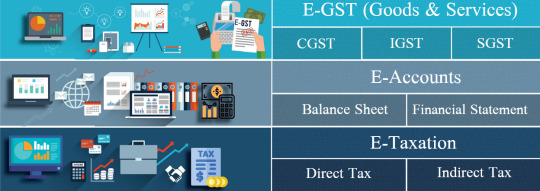
Consequences of Late Filing of GST Returns
Filing GST returns after the due date attracts penalties and interest:
Late Fee: ₹50 per day (₹25 CGST + ₹25 SGST) for normal taxpayers, and ₹20 per day (₹10 CGST + ₹10 SGST) for NIL returns.
Interest: 18% per annum on the outstanding tax liability.
Restriction on ITC Claims: Late filers may lose access to input tax credits.
Suspension of GST Registration: Continuous non-compliance may lead to suspension or cancellation of GST registration.
Conclusion
Staying compliant with GST return filing is crucial for businesses to avoid penalties and ensure smooth tax operations. Taxpayers should stay updated with GST norms, maintain proper records, and file returns on time to remain compliant. If needed, professional assistance can help in managing GST efficiently. GST Training Institute in Delhi
For more insights on GST compliance, keep following our blog!
Contact Us:
SLA Consultants India
82-83, 3rd Floor, Vijay Block,
Above Titan Eye Shop,
Metro Pillar No. 52,
Laxmi Nagar,New Delhi,110092
Call +91- 8700575874
E-Mail: [email protected]
Website: https://www.slaconsultantsindia.com/
0 notes
Text
Best Business Loan Services in Vijayapura, Karnataka
Vijayapura, Karnataka, is emerging as a hub for small and medium-sized enterprises (SMEs) and entrepreneurs. The need for financial assistance is crucial for business expansion, operational improvements, and inventory management. Business loans play a vital role in ensuring that businesses in Vijayapura get the necessary financial backing to achieve their goals.
Understanding Business Loans in Vijayapura
Business loans are financial products designed to support enterprises with working capital, equipment purchases, and expansion efforts. In Vijayapura, multiple financial institutions, including banks, non-banking financial companies (NBFCs), and cooperative societies, offer tailored loan products to meet different business needs.
Business owners looking for loans can benefit from several schemes that cater to startups, MSMEs, and established enterprises. The key factors to consider when applying for a business loan in Vijayapura include interest rates, loan tenure, eligibility criteria, and repayment flexibility.
Types of Business Loans Available in Vijayapura
1. Working Capital Loans
Working capital loans are essential for businesses that require immediate financial support to cover day-to-day operational expenses. These loans help companies manage cash flow, pay suppliers, and meet short-term obligations.
2. Machinery and Equipment Loans
For businesses involved in manufacturing and production, acquiring advanced machinery is crucial. These loans help enterprises purchase new equipment or upgrade existing ones to enhance productivity and efficiency.
3. Term Loans
Term loans are typically used for long-term investments such as business expansion, purchasing commercial property, or investing in infrastructure. These loans come with fixed repayment schedules and are ideal for enterprises planning major developments.
4. Invoice Financing
Businesses that face delayed payments from clients can use invoice financing to access funds quickly. This type of loan allows businesses to receive advance payments based on outstanding invoices, ensuring smooth cash flow management.
5. Government-Backed Business Loans
Several government schemes promote entrepreneurship and small business growth in Vijayapura. Programs such as MUDRA loans, Stand-Up India, and PMEGP offer financial assistance with lower interest rates and easier repayment terms.
Key Features of Business Loan Services in Vijayapura
Flexible Loan Amounts – Business loans in Vijayapura range from small working capital loans to large funding options for major expansions.
Competitive Interest Rates – Depending on the lender and loan type, interest rates can vary, offering businesses cost-effective borrowing solutions.
Quick Processing and Disbursement – Many lenders provide fast loan approvals, ensuring businesses get access to funds without delays.
Collateral-Free Loans – Some financial institutions offer unsecured business loans, eliminating the need for collateral.
Customizable Repayment Options – Borrowers can select repayment plans based on business cash flow and financial stability.
How to Choose the Right Business Loan in Vijayapura
1. Assess Your Business Needs
Before applying for a loan, identify the purpose and amount required. Whether it is for equipment purchase, expansion, or working capital, choosing the right loan type is essential.
2. Compare Interest Rates and Terms
Different lenders offer various interest rates and repayment terms. Comparing these factors ensures that businesses select the most affordable and flexible option.
3. Check Eligibility Criteria
Lenders have specific eligibility requirements based on factors such as business turnover, credit score, and operational history. Meeting these criteria increases the chances of loan approval.
4. Understand Loan Repayment Structure
Opt for a loan with a repayment structure that aligns with your business’s cash flow to avoid financial strain.
5. Choose a Reputable Lender
Selecting a reliable financial institution with a good track record in business lending ensures smooth transactions and better support.
Documents Required for Business Loans
When applying for a business loan in Vijayapura, the following documents are commonly required:
Business registration certificate
PAN card and Aadhaar card of the business owner
Bank statements for the last 6-12 months
Income tax returns
Financial statements such as profit & loss accounts and balance sheets
Loan application form with business details
Conclusion
Business loans in Vijayapura, Karnataka, provide crucial financial support to entrepreneurs and SMEs looking to grow and succeed. With multiple options available, businesses can choose loans based on their specific needs and financial situations. By evaluating different loan types, interest rates, and repayment terms, business owners can secure the best financial assistance to achieve their business objectives. Whether it’s for working capital, expansion, or purchasing new equipment, the right business loan can be a game-changer for enterprises in Vijayapura.
0 notes
Text
KIO Tubular Batteries – The Most Trusted Inverter Battery Supplier

In today’s world, where power cuts and voltage fluctuations are common, having a reliable power backup solution is essential. Whether for homes, offices, or industries, a high-quality inverter battery ensures an uninterrupted power supply. KIO Tubular Batteries, a leading inverter battery supplier, provides advanced battery solutions that guarantee efficiency, durability, and long-lasting performance.
Why Choose KIO Tubular Batteries?
KIO Tubular Batteries are designed using cutting-edge technology and premium materials, making them the best choice for inverter applications. Here’s why they stand out:
✔ Unmatched Reliability – Ensures consistent power during outages✔ Long Battery Life – Designed for extended durability and deep cycling✔ High Efficiency – Delivers superior performance with minimal power loss✔ Low Maintenance – Requires minimal water top-ups and upkeep✔ Eco-Friendly – Built with sustainable materials and energy-efficient designs
Features of KIO Tubular Inverter Batteries
1. Advanced Tubular Plate Technology
Provides deep discharge recovery, ensuring long-lasting performance.
Enhances battery efficiency, making it ideal for frequent power cuts.
2. High Backup Power
Designed to offer longer power backup for homes, offices, and industries.
Ideal for areas experiencing frequent and prolonged power outages.
3. Durability & Robust Build
Manufactured using high-quality materials to withstand extreme conditions.
Corrosion-resistant grids ensure longer service life.
4. Low Maintenance & Easy Handling
Requires less frequent water top-ups, reducing maintenance hassles.
Easy to install and operate, making it perfect for residential and commercial use.
5. Fast Charging & High Efficiency
Charges faster than conventional batteries, reducing downtime.
Delivers stable and uninterrupted power, ensuring the smooth operation of appliances.
Applications of KIO Tubular Inverter Batteries
KIO Tubular Batteries are versatile and cater to multiple sectors:
🏠 For Homes – Ensures uninterrupted power for household appliances🏢 For Offices – Keeps essential equipment like computers and lighting running smoothly🏭 For Industries – Supports heavy-duty machinery and critical operations🏫 For Institutions – Provides reliable backup for schools, hospitals, and government buildings
Why KIO Tubular Batteries are the Best Inverter Battery Supplier?
🔹 Premium Quality: Manufactured with the highest industry standards.🔹 Longer Lifespan: Designed to last longer than ordinary inverter batteries.🔹 Affordable & Reliable: Provides the best value for money.🔹 Trusted by Thousands: Used by thousands of satisfied customers across India.🔹 Eco-Friendly Solutions: Committed to sustainable energy storage.
Conclusion
As a leading inverter battery supplier, KIO Tubular Batteries is dedicated to providing high-performance, durable, and efficient inverter battery solutions. Whether you need a reliable backup for your home, office, or industry, KIO Tubular Batteries ensure unmatched power and reliability.
Originl Source - https://medium.com/@kiobattery/kio-tubular-batteries-the-most-trusted-inverter-battery-supplier-137c99b663c6
0 notes
Text
Explain secure data sharing and use cases for cross-organization collaboration.

Secure Data Sharing and Use Cases for Cross-Organization Collaboration In today’s data-driven world, organizations frequently need to share data securely across departments, partners, vendors, and regulatory bodies.
Secure data sharing ensures that sensitive data is protected while enabling seamless collaboration, analytics, and decision-making.
🔐 What Is Secure Data Sharing?
Secure data sharing refers to controlled access to data across different organizations or business units without compromising security, privacy, or compliance.
Modern cloud platforms offer mechanisms that allow governed, permission-based sharing without physically moving or duplicating data.
Key Features of Secure Data Sharing:
✅ Access Control — Fine-grained permissions control who can access data.
✅ Encryption & Masking — Protects sensitive data in transit and at rest.
✅ Audit Logging — Tracks who accessed what data and when.
✅ Federated Identity Management — Ensures only authorized users access shared data.
✅ Multi-Cloud & Hybrid Support — Enables secure sharing across different cloud providers. 🛠 Technologies for Secure Data Sharing Various platforms offer secure data-sharing features, including:
1️⃣ Azure Synapse Analytics & Azure Data Share Azure Data Share enables organizations to share data without duplication. Synapse Analytics allows cross-team collaboration while enforcing access policies.
2️⃣ AWS Data Exchange & Lake Formation AWS Lake Formation provides fine-grained access control for shared data lakes. AWS Data Exchange allows businesses to subscribe to third-party data securely.
3️⃣ Snowflake Secure Data Sharing Enables real-time, zero-copy data sharing across organizations without moving data. Supports row- and column-level security for precise control.
4️⃣ Google BigQuery Data Sharing Uses authorized views and datasets for multi-tenant collaboration. 📌 Use Cases for Cross-Organization Collaboration
1️⃣ Enterprise Data Sharing Across Departments
📊 Use Case: A large multinational company wants to share HR, finance, and marketing data across different departments while maintaining strict access controls.
✅ Solution: Using Snowflake Secure Data Sharing or Azure Data Share, teams can access only the data they are authorized to see, eliminating the need for redundant data copies.
2️⃣ Partner & Vendor Collaboration
🔗 Use Case: A retail company wants to share real-time sales data with suppliers for demand forecasting.
✅ Solution: AWS Lake Formation enables secure data lake sharing, allowing suppliers to access live sales trends while maintaining customer privacy through data masking.
3️⃣ Data Monetization & Marketplace Models 💰 Use Case: A financial institution wants to sell anonymized transaction data to third-party analytics firms.
✅ Solution: AWS Data Exchange or Snowflake enables governed, controlled data sharing with external consumers without exposing personal details.
4️⃣ Healthcare & Research Collaboration
🏥 Use Case: Hospitals and pharmaceutical companies collaborate on medical research while complying with HIPAA & GDPR regulations.
✅ Solution: Federated data sharing models allow hospitals to run analytics on combined datasets without sharing raw patient records.
5️⃣ Regulatory & Compliance Reporting
📜 Use Case: Banks must share financial transaction data with regulators without violating privacy laws.
✅ Solution: Secure APIs with token-based authentication provide regulators with controlled access while maintaining an audit trail.
🔐 Best Practices for Secure Data Sharing
🔹 Role-Based Access Control (RBAC): Assign access rights based on user roles.
🔹 Data Masking & Anonymization: Protect sensitive PII data before sharing.
🔹 Encryption (TLS & AES-256): Encrypt data in transit and at rest.
🔹 Federated Authentication (OAuth, SAML): Ensure secure identity verification.
🔹 Zero Trust Architecture: Implement least privilege access policies.
🚀 Conclusion
Secure data sharing is crucial for modern enterprises looking to collaborate efficiently while protecting data privacy. Technologies like Azure Data Share, Snowflake, and AWS Lake Formation enable organizations to share data securely across departments, partners, and regulators.
By following best practices and using the right platforms, businesses can unlock secure, compliant, and scalable data collaboration.

0 notes
Text

LETTERS FROM AN AMERICAN
March 1, 2024
HEATHER COX RICHARDSON
MAR 2, 2024
Today, President Joe Biden signed the continuing resolution that will give lawmakers another week to finalize appropriations bills. Lawmakers will continue to hash out the legislation that will fund the government.
Republicans have been stalling the appropriations bills for months. In addition to inserting their own extremist cultural demands in the measures, they have demanded budget cuts to address the fact that the government spends far more money than it brings in.
As soon as Mike Johnson (R-LA) became House speaker, he called for a “debt commission” to address the growing budget deficit. This struck fear into the hearts of those eager to protect Social Security and Medicare, because when Johnson chaired the far-right Republican Study Committee in 2020, it called for cutting those popular programs by raising the age of eligibility, lowering cost-of-living adjustments, and reducing benefits for retirees whose annual income is higher than $85,000. Lawmakers don’t want to take on such unpopular proposals, so setting up a commission might be a workaround.
Last month, the House Budget Committee advanced legislation that would create such a commission. The chair of the House Budget Committee, Jodey C. Arrington (R-TX), told reporters that Speaker Johnson was “100% committed to this commission” and wanted to attach it to the final appropriations legislation for fiscal year 2024, the laws currently being hammered out.
Congress has not yet agreed to this proposed commission, and a recent Data for Progress poll showed that 70% of voters reject the idea of it.
This week, a new report from the Institute on Taxation and Economic Policy (ITEP), a nonprofit think tank that focuses on tax policy, suggested that the cost of tax cuts should be factored into any discussions about the budget deficit.
In 2017 the Trump tax cuts slashed the top corporate tax rate from 35% to 21% and reined in taxation for foreign profits. The ITEP report looked at the first five years the law was in effect. It concluded that in that time, most profitable corporations paid “considerably less” than 21% because of loopholes and special breaks the law either left in place or introduced.
From 2018 through 2022, 342 companies in the study paid an average effective income tax rate of just 14.1%. Nearly a quarter of those companies—87 of them—paid effective tax rates of under 10%. Fifty-five of them (16% of the 342 companies), including T-Mobile, DISH Network, Netflix, General Motors, AT&T, Bank of America, Citigroup, FedEx, Molson Coors, and Nike, paid effective tax rates of less than 5%.
Twenty-three corporations, all of them profitable, paid no federal tax over the five year period. One hundred and nine corporations paid no federal tax in at least one of the five years.
The Guardian’s Adam Lowenstein noted yesterday that several corporations that paid the lowest taxes are steered by chief executive officers who are leading advocates of “stakeholder capitalism.” This concept revises the idea that corporations should focus on the best interests of their shareholders to argue that corporations must also take care of the workers, suppliers, consumers, and communities affected by the corporation.
The idea that corporate leaders should take responsibility for the community rather than paying taxes to the government so the community can take care of itself is eerily reminiscent of the argument of late-nineteenth-century industrialists.
When Republicans invented national taxation to meet the extraordinary needs of the Civil War, they immediately instituted a progressive federal income tax because, as Representative Justin Smith Morrill (R-VT) said, “The weight [of taxation] must be distributed equally, not upon each man an equal amount, but a tax proportionate to his ability to pay.”
But the wartime income tax expired in 1872, and the rise of industry made a few men spectacularly wealthy. Quickly, those men came to believe they, rather than the government, should direct the country’s development.
In June 1889, steel magnate Andrew Carnegie published what became known as the “Gospel of Wealth” in the popular magazine North American Review. Carnegie explained that “great inequality…[and]...the concentration of business, industrial and commercial, in the hands of a few” were “not only beneficial, but essential to…future progress.” And, Carnegie asked, “What is the proper mode of administering wealth after the laws upon which civilization is founded have thrown it into the hands of the few?”
Rather than paying higher wages or contributing to a social safety net—which would “encourage the slothful, the drunken, the unworthy,” Carnegie wrote—the man of fortune should “consider all surplus revenues which come to him simply as trust funds, which he is called upon to administer…in the manner which, in his judgment, is best calculated to produce the most beneficial results for the community—the man of wealth thus becoming the mere trustee and agent for his poorer brethren, bringing to their service his superior wisdom, experience, and ability to administer, doing for them better than they would or could do for themselves.”
“[T]his wealth, passing through the hands of the few, can be made a much more potent force for the elevation of our race than if distributed in small sums to the people themselves,” Carnegie wrote. “Even the poorest can be made to see this, and to agree that great sums gathered by some of their fellow-citizens and spent for public purposes, from which the masses reap the principal benefit, are more valuable to them than if scattered among themselves in trifling amounts through the course of many years.”
Here in the present, Republicans want to extend the Trump tax cuts after their scheduled end in 2025, a plan that would cost $4 trillion over a decade even without the deeper cuts to the corporate tax rate Trump has called for if he is reelected. Biden has called for preserving the 2017 tax cuts only for those who make less than $400,000 a year and permitting the rest to expire. He has also called for higher taxes on the wealthy and corporations, which would generate more than $2 trillion.
Losing the revenue part of the budget equation and focusing only on spending cuts seems to reflect a society like the one the late-nineteenth-century industrialists embraced, in which a few wealthy leaders get to decide how to direct the nation’s wealth.
In other news today, Alexei Navalny’s parents held a funeral for the Russian opposition leader and buried him in Moscow. Navalny died two weeks ago at a penal colony in Siberia where Russian president Vladimir Putin had imprisoned him on trumped-up charges after failing to kill him with poison. Navalny fought against Putin’s control of Russia by emphasizing the corruption and illicit fortunes of Putin and his associates.
Russia specialist Julia Ioffe of Puck News noted that a million Russians have fled the country since the February 2022 invasion of Ukraine and that many of them were Navalny supporters. Still, many thousands turned out for the funeral and the procession, throwing flowers at the hearse as it made its way to the cemetery.
A woman at Navalny’s funeral compared Navalny and Putin. “One sacrificed himself to save the country, the other one sacrificed the country to save himself.”
LETTERS FROM AN AMERICAN
HEATHER COX RICHARDSON
#Corporations#taxes#Corporate tax#trickle down economics#democracy#finance#Heather Cox Richardson#Letters from An American#theocracy#social security
6 notes
·
View notes
Text
Innovating Supply Chain Management Through Legal and Ethical Compliance

In an increasingly interconnected world, supply chain management has evolved from a functional necessity to a strategic differentiator for businesses. As companies face heightened expectations to deliver goods faster, cheaper, and more sustainably, legal and ethical compliance has emerged as a critical cornerstone of innovation in supply chain operations. This article explores how businesses are leveraging compliance to drive innovation, foster sustainability, and enhance their global competitiveness.
The Role of Legal and Ethical Compliance in Supply Chains
Supply chains operate in a complex regulatory environment shaped by trade policies, environmental standards, labor laws, and anti-corruption measures. Legal compliance ensures businesses adhere to these requirements, avoiding fines, reputational damage, and disruptions. Ethical compliance, on the other hand, encompasses voluntary commitments to human rights, fair labor practices, and sustainability. Together, these principles provide a foundation for businesses to innovate and differentiate themselves.
1. Strengthening Trust and Transparency
Legal and ethical compliance enables businesses to establish transparent supply chains. Digital technologies like blockchain are being adopted to provide traceability, ensuring compliance with laws such as the Modern Slavery Act and environmental standards. Companies like Nestlé have implemented blockchain to trace coffee beans from farmers to consumers, ensuring ethical sourcing and boosting consumer trust.
2. Driving Sustainability Through Innovation
Compliance with environmental regulations has encouraged companies to develop sustainable practices. For instance, the European Union's carbon-neutral goals have driven businesses to innovate in energy-efficient transportation and packaging. Companies like Unilever have adopted circular economy models, reusing materials and reducing waste in compliance with these laws, creating both cost savings and environmental benefits.
3. Streamlining Processes with Digital Transformation
Compliance often necessitates process improvements, leading to operational innovation. Regulatory requirements around data privacy, such as the General Data Protection Regulation (GDPR), have pushed companies to innovate in data security and logistics systems. Digital platforms now integrate compliance checks, automate documentation, and monitor supplier practices, reducing administrative burdens while improving efficiency.
Challenges and Opportunities
Challenges
Complexity Across Jurisdictions: Navigating diverse legal frameworks in global supply chains can be challenging.
Cost of Compliance: Meeting stringent regulations often involves significant financial investment.
Opportunities
Public-Private Partnerships: Collaborating with governments can foster compliance-friendly policies that encourage innovation.
Competitive Advantage: Ethical and legal compliance enhances brand value and attracts socially conscious consumers.
Conclusion
Innovating supply chain management through legal and ethical compliance is no longer an option—it is a business imperative. Companies that integrate compliance into their strategies not only mitigate risks but also unlock new opportunities for efficiency, sustainability, and growth. By embracing technologies like blockchain and prioritizing transparency, businesses can ensure compliance while fostering innovation, strengthening their position in a competitive global market.
Under the Poddar Business School's exclusive ‘Students Development Program’ at the esteemed IIM Indore, the PGDM program students underwent rigorous training on Business Simulation, Case Studies and Innovative Research. Poddar Business School is a leading management institution in Jaipur. With many years of excellence, the management institute offers the best PGDM and MBA programs.
0 notes
Text
Why Bangalore is a Hub for Structural Steel Manufacturing
Bangalore, often referred to as the “Silicon Valley of India,” is not only a technology powerhouse but also a significant player in the alloy steel industry in India. Over the years, the city has emerged as a critical hub for structural steel manufacturing, serving industries such as construction, automotive, and infrastructure development. This growth is fueled by several factors, including its strategic location, well-developed industrial ecosystem, and the presence of top alloy steel manufacturers in India.
Strategic Location and Connectivity
Bangalore’s location in Karnataka, a state rich in mineral resources, plays a pivotal role in its prominence in the steel industry. The state is home to some of the top steel manufacturers in Karnataka, offering a steady supply of raw materials required for manufacturing structural steel. Moreover, Bangalore’s excellent connectivity to major ports like Chennai and Mangalore facilitates smooth import and export of steel products, helping alloy steel manufacturers company in Karnataka reach global markets efficiently.
Thriving Industrial Ecosystem
The city’s robust industrial base supports the alloy steel manufacturers company in India, making Bangalore a hotspot for innovation and large-scale production. The presence of a thriving construction industry has increased the demand for TMT bars suppliers in India, with Bangalore-based manufacturers providing top-quality products to meet the growing need for durable and resilient building materials.
Additionally, the rise of high-tech industries, coupled with government incentives, has encouraged alloy steel manufacturers in India to set up advanced production facilities in and around Bangalore. These facilities are equipped with state-of-the-art technology, ensuring the production of the best sariya in India and other high-grade structural steel products.
Demand for High-Quality TMT Bars and Alloy Steel
One of the key reasons behind Bangalore’s dominance in structural steel manufacturing is the rising demand for high-quality materials such as TMT bars brand in India and top quality sariya in India. These products are essential for constructing high-rise buildings, bridges, and industrial plants, where durability and strength are paramount. Manufacturers in Bangalore are known for producing corrosion-resistant, earthquake-resistant, and cost-effective steel products, which have earned them a stellar reputation across the country.
The city also serves as a center for producing specialized alloy steel, with numerous alloy steel manufacturers company in Karnataka catering to diverse industries like aerospace, defense, and automotive. The versatility and high-performance characteristics of alloy steel in Bangalore make it a preferred choice for projects requiring superior mechanical properties.
Supporting Infrastructure and Skilled Workforce
Bangalore’s advanced infrastructure and a skilled workforce have further solidified its position as a hub for structural steel manufacturing. The availability of research and development centers has enabled alloy steel manufacturers in India to innovate and produce world-class products. Additionally, the presence of educational institutions and training programs ensures a steady supply of qualified professionals to the industry.
CONCLUSION:
The combination of strategic advantages, industrial support, and technological expertise has positioned Bangalore as a key player in the alloy steel industry in India. With its focus on producing high-quality materials such as TMT bars brand in India and best sariya in India, the city is set to maintain its leadership in structural steel manufacturing, driving growth and innovation in the sector.
0 notes
Text
Shelf Corporation for Sale: A Business Owner’s Advantage

Are you looking to launch a business quickly? Perhaps you’ve heard of a Shelf Corporation for Sale and wondered how it could benefit you. A shelf corporation is a pre-registered business entity that has been set aside, or "shelved," by the original owner, awaiting sale to new buyers. These companies are typically well-established and can offer various advantages for business owners looking to bypass the hurdles of creating a company from scratch.
What is a Shelf Corporation for Sale?
A Shelf Corporation for Sale is essentially a company that has been legally created and exists on paper but has not yet engaged in any significant business activities. These corporations have an established legal history, which can be an attractive feature for many entrepreneurs. By purchasing a shelf corporation, you can acquire a business that already has a track record, which can be essential in establishing credibility with investors, lenders, and customers.
The Benefits of Purchasing a Shelf Corporation
When looking to purchase a Shelf Corporation for Sale, business owners gain several distinct advantages. First, there’s the advantage of time. Starting a new business involves paperwork, approvals, and often long waiting periods. With a shelf corporation, the process is accelerated. Here are a few notable benefits:
Instant Credibility: A shelf corporation comes with an established name and history, which means it is often viewed as more credible than a new entity. Lenders, suppliers, and even clients are more likely to trust a business that has been around for a while, even if it hasn’t been operational.
Access to Business Loans and Credit: Financial institutions are more likely to extend business credit to companies that have been in existence for some time. A shelf corporation with a few years of age can help you bypass some of the barriers new businesses face when applying for financing.
Easier Entry into Contracts: Many government contracts and business agreements require that companies have been in business for a certain period. A shelf corporation can help you meet those requirements right away, giving you a leg up in competitive industries.
Quick Start for International Expansion: If you're looking to expand your business internationally, having an established company can simplify the process. Many countries prefer to deal with corporations that have a history, which can make entering foreign markets faster and smoother.
How to Choose the Right Shelf Corporation for Sale
It’s important to carefully consider the right Shelf Corporation for Sale before making a purchase. Look for a company with a clean legal record, minimal debt, and no ongoing liabilities. Ensure that it aligns with the type of business you intend to run, and verify that it complies with the legal and regulatory requirements in your industry.
One factor to consider is the age of the corporation. An older shelf corporation typically carries more weight in the eyes of potential business partners and financial institutions. However, older doesn’t always mean better—it’s crucial to balance the age with the overall financial health and legitimacy of the business.
Is a Shelf Corporation Right for Your Business?
If you’re eager to skip the startup process and jump straight into business ownership, a Shelf Corporation for Sale could be the perfect solution. It’s particularly advantageous if you’re seeking to build trust with potential partners or investors right from the start. But, like any business decision, it’s important to thoroughly research your options and choose a company that best fits your goals.
Conclusion
In conclusion, purchasing a Shelf Corporation for Sale offers numerous benefits for business owners looking to quickly establish a credible and operational company. Whether you're aiming for business loans, contracts, or international expansion, a shelf corporation provides an established foundation that can open many doors. If you're considering a Shelf Corporation for Sale, make sure to carefully evaluate the options available and choose one that best suits your business needs.
For those looking to explore more about purchasing a shelf corporation online, WholesaleShelfCorporations.com offers a variety of options to suit different business goals. Their comprehensive services make it easier for you to find the perfect shelf corporation to jumpstart your business.
0 notes
Text
Starting a new business can be an exciting yet challenging journey. One of the first crucial steps in establishing a successful startup is officially registering your business. At A2Z Tender, we offer comprehensive startup registration services to help you navigate the legal and administrative processes with ease. Whether you’re starting a small enterprise or planning to scale rapidly, we provide expert guidance and support to get your business off the ground.
Why Register Your Startup?
Before launching your startup, it's important to ensure it's legally recognized. Registering your business offers several benefits:
Legal Protection: Your business is officially recognized by the government, which protects your brand and intellectual property.
Access to Funding: Many investors and financial institutions require that your business is properly registered before offering funding or loans.
Credibility: A registered startup adds legitimacy and trust, helping to build confidence with customers, suppliers, and partners.
Tax Benefits: Registered businesses are eligible for tax benefits, rebates, and exemptions, helping you reduce financial burden.
Our Startup Registration Services
At A2Z Tender, we provide end-to-end support for startup registration, ensuring that you follow all necessary legal steps. Our services include:
1. Business Structure Consultation
Choosing the right business structure is vital for the growth and management of your startup. We help you decide whether a sole proprietorship, partnership, limited liability partnership (LLP), private limited company, or another structure is best suited for your needs. Our experts offer insights into the pros and cons of each option, considering factors such as tax implications, liability protection, and scalability.
2. Company Name Registration
Choosing the right name for your startup is essential for brand identity. We assist you with registering your business name, ensuring it is unique and complies with legal requirements. We also conduct thorough checks to avoid any conflicts with existing trademarks or business names.
3. Documentation Assistance
Startup registration requires a range of official documents, including:
Identity Proofs of the founders or directors.
Address Proof for the business.
PAN Card (for Indian businesses).
MOA (Memorandum of Association) and AOA (Articles of Association) for companies.
We guide you through the process, ensuring that all the necessary paperwork is correctly prepared and submitted to the appropriate authorities.
4. Digital Signature Certificate (DSC)
A Digital Signature Certificate (DSC) is mandatory for certain types of company registrations. We assist you in obtaining a DSC, which is required for e-filing and signing official documents.
5. GST Registration
If your startup will be involved in the sale of goods or services, GST registration is essential. Our team helps you understand the Goods and Services Tax (GST) system and facilitates the registration process, ensuring that your business complies with tax regulations from day one.
6. PAN and TAN Registration
Obtaining Permanent Account Number (PAN) and Tax Deduction Account Number (TAN) is crucial for tax purposes. We help you apply for both, ensuring your startup is fully compliant with Indian tax laws.
7. Trademark Registration
Protect your brand with trademark registration. We offer assistance in registering your brand’s name, logo, or tagline, helping to safeguard your intellectual property and prevent unauthorized use.
8. Compliance and Advisory Services
Once your startup is registered, compliance with ongoing legal requirements is crucial. We offer advisory services to help you manage annual filings, tax returns, and other statutory obligations, ensuring your business stays compliant with government regulations.
Why Choose A2Z Tender for Startup Registration?
1. Expertise in Startup Registration
With years of experience in the field, our team of professionals is well-versed in the complexities of startup registration. We handle all aspects of the process, allowing you to focus on building your business.
2. Hassle-Free Process
We simplify the registration process, taking care of all the paperwork, filings, and interactions with government authorities. You can rest assured that your registration will be handled efficiently and without stress.
3. Affordable and Transparent Pricing
Our startup registration services are designed to be affordable, with no hidden fees. We offer transparent pricing so you can plan your budget with confidence.
4. Timely Completion
We understand the importance of time when starting a new business. Our team ensures that your registration is completed quickly, allowing you to launch your startup without unnecessary delays.
5. Ongoing Support
At A2Z Tender, our support doesn’t end once your startup is registered. We provide continuous support, offering guidance on legal compliance, accounting, taxation, and more as your business grows.
Get Started with A2Z Tender
Registering your startup with A2Z Tender means having a trusted partner by your side to guide you through every step of the process. Our expert team is committed to helping you successfully navigate the complexities of business registration, ensuring your startup is compliant, efficient, and ready for success. Take the first step towards turning your entrepreneurial dreams into reality. Contact us today to learn more about our startup registration services and get started with your business registration today!
0 notes